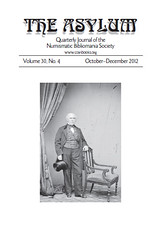
About UsThe Numismatic Bibliomania Society is a non-profit organization promoting numismatic literature. For more information please see our web site at coinbooks.org SubscriptionsThose wishing to become new E-Sylum subscribers (or wishing to Unsubscribe) can go to the following web page link MembershipThere is a membership application available on the web site Membership Application To join, print the application and return it with your check to the address printed on the application. Membership is only $15 to addresses in the U.S., $20 for First Class mail, and $25 elsewhere. For those without web access, write to: David M. Sundman, Secretary/TreasurerNumismatic Bibliomania
Society AsylumFor Asylum mailing address changes and other membership questions, contact David at this email address: dsundman@LittletonCoin.com SubmissionsTo submit items for publication in The E-Sylum, just Reply to this message, or write to the Editor at this address: whomren@coinlibrary.com
BUY THE BOOK BEFORE THE COINYou won't regret it! |
- WAYNE'S WORDS: THE E-SYLUM FEBRUARY 3, 2013
- THE ASYLUM OCTOBER–DECEMBER 2012 ISSUE PUBLISHED
- KOLBE & FANNING 128TH MAIL-BID SALE ANNOUNCED
- NEW BOOK: THE REFERENCE LIBRARY OF A NUMISMATIC BOOKSELLER
- NEW BOOK: PATTERN AND EXPERIMENTAL PIECES OF WW-II
- NEW BOOK: ALMANAC OF UNITED STATES COINS
- NEW BOOK: CUPROUS IRANIAN COINS
- NEW BOOK: FRENCH MEDALLIC ART IN THE 19TH AND 20TH CENTURY
- NEW BOOK: THE LIBRARIAN'S COPYRIGHT COMPANION, 2ND EDITION
- BOOK REVIEW: ENCYCLOPEDIA OF THE COMMEMORATIVE COINS OF THE U.S.
- BOOK REVIEW: ABRAHAM LINCOLN - BEYOND THE AMERICAN ICON
- BOOK REVIEW: MORE ON ABRAHAM LINCOLN - BEYOND THE AMERICAN ICON
- THE NUMISMATIST CELEBRATES ITS 125TH ANNIVERSARY
- ON THE 'FIRST' 1794 DOLLAR
- WALTON 1913 LIBERTY NICKEL TO BE AUCTIONED IN APRIL 2013
- GEORGE WALTON PHOTO IDENTIFICATION
- A THEORY ON THE 1811-DATED "OIE DIOE" TOKEN
- NOTES FROM E-SYLUM READERS: FEBRUARY 3, 2013
- NEW TECHNOLOGY CREATES NUMISMATIC ITEMS IN 3D
- ANS RETRIEVES ANOTHER 7,291 HUNTINGTON COINS
- QUERY: INFORMATION ON KRUPP MINTING EQUIPMENT AND COINS SOUGHT
- CARNEGIE HERO MEDAL TO FEATURE ON PAWN STARS TV SHOW
- 1888 AUSTRALIAN SETTLEMENT MEDAL BY WILLIAM JOSEPH AMOR
- MARK TWAIN'S THE £1,000,000 BANK-NOTE
- HARVEY STACK ON THE GREAT COIN AUCTIONS OF 1954
- MORTON & EDEN TO SELL DUPLICATE 1859 U.S. PROOF SET
- GORNY & MOSCH AUCTION SALE 123 FEATURES HISTORICAL MEDALS
- KÜNKER AUCTIONS MARCH 11 TO 16, 2013
- 1811 DISS VOLUNTEER INFANTRY MEDAL
- LOST WWI MEDAL FOUND IN SEWER RETURNED TO OWNERS
- BOOK COLLECTING 101
- BRANDYWINE RIVER MUSEUM EXHIBIT OF F.O.C. DARLEY'S BANK NOTES
- THE HIGHLAND MINT AND THE 2013 SUPERBOWL COIN
- FEATURED WEB PAGE: NATIONAL NUMISMATIC COLLECTION
WAYNE'S WORDS: THE E-SYLUM FEBRUARY 3, 2013

New subscribers this week include Katie Rissetto of the American Numismatic Society, Dennis Forgue, Louis Caravella and Stanley Campbell. Welcome aboard! We have 1,622 email subscribers, plus 210 followers on Facebook.
This week we open with information on the latest issue of our print journal, The Asylum, followed by notes from numismatic booksellers Kolbe & Fanning. Next up are announcements of SIX new books and three numismatic book reviews.
Other topics include the recently sold 1794 dollar, George Walton and his 1913 Liberty Head nickel, the 125th anniversary of The Numismatist, the making of this year's Superbowl coin, and a new technology for creating numismatic items.
To learn more about French medallic art, the pattern and experimental pieces of WWII, ephemera of commemorative coinage, Krupp minting equipment, The Richest Man in Confederate Money, The Man Who Slept in the Library of Parliament, bank note engraver F.O.C. Darley and the medal that came from the sewer, read on. Have a great week, everyone!
Wayne Homren
Editor, The E-Sylum
THE ASYLUM OCTOBER–DECEMBER 2012 ISSUE PUBLISHED
David Yoon, editor of the Numismatic Bibliomania Society's print journal writes:
Another issue of The Asylum is at the printers. Here are the contents:
- Chris Faulkner - The Man Who Slept in the Library of Parliament
- Joel J. Orosz - The United States Postal Guide and Official Advertiser: A Pioneering Numismatic Journal
- Leonard D. Augsburger - Liberty Seated Quarter Literature
- David F. Fanning - Edward Cogan's 1871 Montreal Sale
- George F. Kolbe - Kolbe & Fanning's 2013 New York Book Auction
- D. Wayne Johnson - Book Review (Unusual World Coins, 6th ed.)
- Serge Pelletier - Book Review (Le pesage monétaire)
For more information on the Numismatic Bibliomania Society, see: www.coinbooks.org
KOLBE & FANNING 128TH MAIL-BID SALE ANNOUNCED
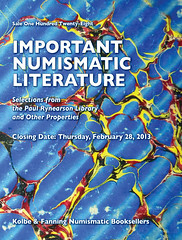 Kolbe & Fanning Numismatic Booksellers have announced their 128th mail-bid sale of important numismatic books, which will close on Thursday, February 28. Featuring selections from the Paul Rynearson library and other properties, the sale includes hundreds of standard works on ancient coins, as well as a variety of works on medieval, foreign and U.S. numismatics.
Kolbe & Fanning Numismatic Booksellers have announced their 128th mail-bid sale of important numismatic books, which will close on Thursday, February 28. Featuring selections from the Paul Rynearson library and other properties, the sale includes hundreds of standard works on ancient coins, as well as a variety of works on medieval, foreign and U.S. numismatics.
The sale is composed of 1267 lots of literature covering the entire range of numismatics. Highlights include:
—A complete set of the Forni reprint of the massive Corpus Nummorum Italicorum, the masterpiece of King Victor Emmanuel III of Italy (lot 204)
—The complete presentation editions of the Bowers & Ruddy/Merena sales of the Garrett, Norweb, Eliasberg and Brand collections, as issued in three imposing volumes, one of only 15 possible sets (lot 914)
—A plated copy of Henry Chapman’s enormous catalogue of the John Story Jenks collection, with 42 photographic plates (lot 949) —The Marquess of Milford Haven’s landmark British Naval Medals (lot 526)
—G. Kenneth Jenkins’s important The Coinage of Gela (lot 399)
—An 1871 broadside catalogue of a Bangs, Merwin & Co. coin sale (lot 889)
—An original 1875 Crosby on The Early Coins of America (lot 976)
—John Muscalus’s original manuscript of his doctoral dissertation, Early Banking Enterprises in Relation to the Development of Public Education (lot 1127).
Bids may be placed via mail, email, phone or fax. The printed catalogue has been sent to customers on the Kolbe & Fanning mailing list. A limited number of copies remain available for purchase for $15 postpaid. The catalogue also may be downloaded in PDF form from the Kolbe & Fanning website at www.numislit.com. For full bidding instructions, please see the catalogue and read the terms of sale.
For more information or to place bids, please contact David Fanning at df@numislit.com or (614) 414-0855. Thank you, and we look forward to your participation!
NEW BOOK: THE REFERENCE LIBRARY OF A NUMISMATIC BOOKSELLER
In December of 2012, the following book was published:
A NUMISMATIC BOOKSELLER
Compiled by George F. Kolbe
Privately Printed: Cedarpines Park, 2012.
Edition Limited to 150 Copies and 10 on Large Paper.
335 pages, illustrated. Cloth, leather spine label.
 The book begins with a foreword by Jonathan H. Kagan and the preface traces the early years of Kolbe’s career as a numismatic bookseller. It is followed by a brief introduction. Interesting and informative notes and commentary will be found throughout the book, including anecdotes, observations on the importance and rarity of certain titles, including their scope and content, etc.
The book begins with a foreword by Jonathan H. Kagan and the preface traces the early years of Kolbe’s career as a numismatic bookseller. It is followed by a brief introduction. Interesting and informative notes and commentary will be found throughout the book, including anecdotes, observations on the importance and rarity of certain titles, including their scope and content, etc.
The volume comprises a detailed catalogue of the compiler’s reference library, formed over four decades as a dealer in rare and out of print numismatic publications. In essence it is a bibliography of numismatic bibliographies and related publications. While the author makes no claim of completeness, well over one thousand publications are listed and described, organized into categories such as early numismatic bibliographies (listed chronologically); numismatic bibliographies published from 1822 to 2012 (arranged by topic or locale); economic, financial, and banking bibliographies; philatelic reference works with numismatic content; numismatic library and exhibition catalogues; numismatic bookplates; numismatic institution and society histories; numismatic biographies; numismatic directories; numismatic literature auction sale catalogues; and various other headings.
Despite a narrowly defined focus, it is hoped that the book will be more generally useful to serious numismatic researchers, collectors and dealers by both its organization and extensiveness. Seventy-five copies of the regular edition, 7.5 by 10.25 inches, remain available for sale, each priced at $195.00 plus shipping. Inquiries or orders may be sent directly to the author at P.O. Box 3100, Crestline, CA 92325–3100; email: GFK@numislit.com. The Large Paper copies are attractively bound in quarter leather and are approximately an inch wider and taller than the regular edition. Inquiries on availability and price may be directed to the author.
The book's Foreword by Jonathan Kagan summarizes it well:
"This is no ordinary dealer's reference library; but quite simply the finest specialized library of numismatic bibliography ever established. It is a labor of love and skill that required almost half a century to assemble... When annotated and most importantly, as is the case here, intelligently organized, a bibliography of bibliographies - often called a metabibliography - can be a valuable tool. I have no doubt that "The Reference Library Of A Numismatic Bookseller will be valued by researchers for the next 350 years."
NEW BOOK: PATTERN AND EXPERIMENTAL PIECES OF WW-II
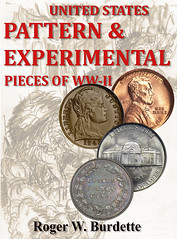 The new research book Pattern and Experimental Pieces of WW-II has been printed and delivered to Wizard Coin Supply. The press run was small which translated to a higher price than I’d like – but I saw no potential for collectors buying 5,000 copies. It is 8x11.5, color, soft cover, 190 pages. $29.95. http://www.wizardcoinsupply.com/products/pattern-coin-books
The new research book Pattern and Experimental Pieces of WW-II has been printed and delivered to Wizard Coin Supply. The press run was small which translated to a higher price than I’d like – but I saw no potential for collectors buying 5,000 copies. It is 8x11.5, color, soft cover, 190 pages. $29.95. http://www.wizardcoinsupply.com/products/pattern-coin-books
This is not only groundbreaking research, but Pattern and Experimental Pieces of WW-II could possibly be the most important contribution of new knowledge to American numismatics of this decade.
Beginning as early as 1940 the US Mint Bureau was under pressure to reduce or eliminate use of certain metals including copper, tin and nickel. From 1941 through 1944, the US Mint conducted multiple experiments to determine the best compositions for the one cent and five cent coins. Sporadic records were kept of the tests and most of the sample examinations were mostly “seat of the pants” than science.
The largest number of tests occurred from May to December 1942 when the mint experimented with metal alloys and private companies, with mint approval, experimented with alternative materials and production methods. Most experiments were failures, but the final outcomes were the zinc coated steel clad composition used in 1943 for cents, and an unstable alloy of silver, manganese and copper for the five cent coin.
Pattern and Experimental Pieces of WW-II follows the development and conduct of these experiments from optimistic hopes to eventual return to conventional coinage alloys. Every company and individual known to have participated is identified along with their role and contributions to the work. Every experimental and pattern piece is identified and cataloged with as much objective information as could be located. Large color photos allow collectors to compare items in their collections with real coins, not faulty catalog descriptions or guesses.
For more information, or to order, see: United States Pattern & Experimental Pieces of WWII (www.wizardcoinsupply.com/united-states-pattern-experimental-pieces-of-wwii.html)
NEW BOOK: ALMANAC OF UNITED STATES COINS
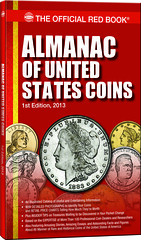 Whitman Publishing announces the release of the first edition of a new book, the Almanac of United States Coins. The 192-page softcover retails for $9.95. It can be purchased from bookstores and hobby retailers nationwide, and online (including at www.Whitman.com).
Whitman Publishing announces the release of the first edition of a new book, the Almanac of United States Coins. The 192-page softcover retails for $9.95. It can be purchased from bookstores and hobby retailers nationwide, and online (including at www.Whitman.com).
The full-color Almanac is designed as an illustrated catalog of useful and entertaining information for newcomers to the hobby as well as longtime coin collectors. It includes detailed photographs for identifying coins by type, grading instructions with enlarged step-by-step photographs, retail price charts telling how much common dates are worth, insight on rarer and more valuable dates, and images of collectible die varieties that can be found in pocket change.

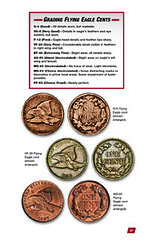
“The Almanac of United States Coins features amusing stories, colorful essays, and astounding facts and figures about all manner of rare and historical coins of the U.S.A.,” said Whitman publisher Dennis Tucker. “One of our goals is to entertain and educate active collectors. But we also want to energize casual hobbyists and encourage them with new ways to explore and collect U.S. coins. A third goal is to broaden the audience for the hobby. The Almanac will be available from mass-market retailers nationwide, beyond the normal venues of coin shows and hobby shops. It’s perfect for anyone who is just discovering coins and wants to learn more.”
Essays describe the history of coinage in America going back to colonial days; aspects of today’s rare-coin market; the importance and techniques of grading; Proof coins; third-party grading and authentication; collecting colonial and early American coins; every type of federal coinage from half cents to double eagles; commemorative coins; Proof and Mint sets; silver, gold, and platinum bullion coins; tokens and medals; coins struck by the U.S. for the Philippines; misstrikes and mint errors; treasures, coin hoards, and shipwrecks; and more.
“The Almanac of United States Coins is a fun, fascinating look at the coins that have fueled American business for more than 350 years,” says Whitman Publishing numismatic director Q. David Bowers. “They’re all here: copper, silver, gold, and more; million-dollar rarities and everyday pocket change; Buffalo nickels, silver dollars, Civil War tokens, old-time ‘pennies’ and the latest Presidential dollars. What are these interesting pieces of American culture? How much are they worth? You’ll find out inside the Almanac of United States Coins.”
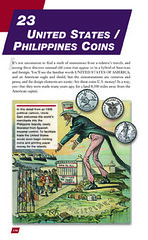
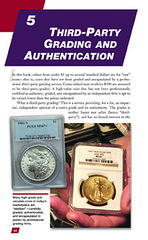
Almanac of United States Coins, 1st edition
Edited by Dennis Tucker
ISBN 079483925-8
Printed in the United States of America
192 pages, softcover, full color
Retail $9.95
For more information, or to order, see: Almanac of United States Coin 1st Edition, 2013 (www.whitman.com/Inventory/Detail/Almanac-of-United-States-Coin-1st-Edition-2013+0794839258)
NEW BOOK: CUPROUS IRANIAN COINS
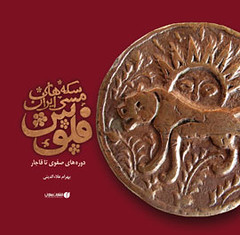 Bahram Ala al-Dini has recently finished authoring Cuprous Iranian Coins; Currency under dynasties from Safavid to Qajar in English and Persian. The work encompasses 300 entries of the coins used as currency under various dynasties in Iran’s history from the Safavid era to the Qajars.
Bahram Ala al-Dini has recently finished authoring Cuprous Iranian Coins; Currency under dynasties from Safavid to Qajar in English and Persian. The work encompasses 300 entries of the coins used as currency under various dynasties in Iran’s history from the Safavid era to the Qajars.
IBNA: Speaking with IBNA, Reza Ebrahimi Nejad, photography and arts advisor of the book, stated that the book is presented in English and Persian to address readers of the two languages.
Each entry of the book provides a picture of the coins, their size, weight and the region they were used, he added. Besides, information about their design and the data conveyed in each one have also been garnered for each of the considered coins.
As he said, coins were minted with various metals to be used for different purposes and places. For example, gold coins were used in royal transactions while cuprous coins were mostly used by common citizens and were struck with pictures of sun or lion. Some, however, were offered with relief pictures of different animals like poultry, sheep, peacocks, sheep, horses and rabbits which indicated the place where the coin was made.
The book’s first release will be marketed by Yasavoli Publishing Company in Iran. It is arranged in 170 pages and 3,000 of its copies have been published.
To read the original Iran Book news Agency announcement, see: Book reviews cuprous coins in Iran (www.ibna.ir/vdcizuaz5t1aqy2.ilct.html)
To read the World of Coins item, see: Book reviews cuprous coins in Iran (www.worldofcoins.eu/forum/index.php?topic=20036)
To read the original Iran Book news Agency announcement, see: Book reviews cuprous coins in Iran (www.ibna.ir/vdcizuaz5t1aqy2.ilct.html)
NEW BOOK: FRENCH MEDALLIC ART IN THE 19TH AND 20TH CENTURY
Nicolas Maier writes:
It took some time for the Musée d’Orsay to make the catalogue accompanying the exhibition ‘La médaille en France aux XIXe et XXe siècles’ available online. With nearly 300 illustrations (partly in colour), it provides a good overview about French medallic art, even if the text is only in French.
The book may be purchased through the French museums boutique’s online shop at the price of EUR 39.99:
www.boutiquesdemusees.fr/en/shops/musee-orsay/exhibition-catalogue-au-creux
-de-la-main-la-medaille-en-france-aux-xixe-et-xxe-siecles/4496.html
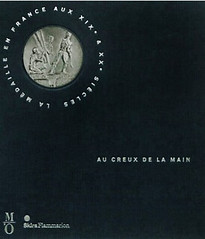 Published on the occasion of the exhibition L'art au creux de la main, la médaille en France aux XIXe et XXe siècles, Petit Palais, Musée des Beaux-Arts de la Ville de Paris, 11th december 2012 to 30 june 2013.
Published on the occasion of the exhibition L'art au creux de la main, la médaille en France aux XIXe et XXe siècles, Petit Palais, Musée des Beaux-Arts de la Ville de Paris, 11th december 2012 to 30 june 2013.
Publisher: Skira Flammarion / Musée d'Orsay
Author: collective under Edouard Papet coordination
EAN: 9782081290792
Nb. of pages: 204
Dimensions: 22,7 x 24,5 x 2,2 cm
Language: French
Publication date: 01/2013
Nicolas adds:
The Paris Mint also has the book on offer, and the price is EUR 39, not 39.99: www.monnaiedeparis.fr/en_US/-/-pcDrxdvKztiksAAAEvPD4l6HPCjZ.sE6zmdGQAAAE8bQUFXGGW.html
To read the earlier E-Sylum article, see: NEW CATALOG: FRENCH MEDALLIC ART IN THE 19TH AND 20TH CENTURY (www.coinbooks.org/esylum_v15n47a05.html)
NEW BOOK: THE LIBRARIAN'S COPYRIGHT COMPANION, 2ND EDITION
Ben Keele writes:
Recently a book I co-authored came out--The Librarian's Copyright Companion, 2nd Edition. It isn't numismatic, but the book does discuss many of the copyright issues that have popped up from time to time in The E-Sylum. The book was written for librarians, but its discussion of copyright rules would be applicable to many E-Sylum readers.
I think the primary value of the book is that it provides practical analysis and advice on copyright issues that affect all types of librarians. The authors are academic law librarians, but we were careful to write it for readers that may not have much familiarity with copyright when they start reading. The book also focuses on what copyright enables libraries to do instead of just what it prevents. Libraries have some copyright exemptions that don't apply to individuals, but patrons could use the book to know what their libraries can do for them. And the chapter on fair use can be used to help make fair use determinations for pretty much anyone.
The book is $49 (I think the publisher priced it assuming mostly libraries would buy it and circulate to its patrons). Interested readers could request it through inter-library loan or suggest their local libraries purchase a copy.
 The Librarian’s Copyright Companion provides a framework that will help librarians analyze the impact of copyright
law in their library. Much has changed (and much hasn’t) since the first edition came out in 2004. The transition from
print to digital continues in periodical collections and academic reserves and repositories. This book is another voice of
copyright, beginning with a different premise: copyright exists to promote the dissemination of information, and while
creators have certain rights, so do users.
The Librarian’s Copyright Companion provides a framework that will help librarians analyze the impact of copyright
law in their library. Much has changed (and much hasn’t) since the first edition came out in 2004. The transition from
print to digital continues in periodical collections and academic reserves and repositories. This book is another voice of
copyright, beginning with a different premise: copyright exists to promote the dissemination of information, and while
creators have certain rights, so do users.
In addition to updating the entire text, the authors have added:
- A new chapter on the library's role as a publisher and how libraries should behave as copyright owners
- Discussions of open licenses like Creative Commons
- Examples of applying copyright to relatively recent digital technologies, the process of determining whether a work is under copyright and obtaining permission to use it
- Recent litigation which examines the extent of fair use and library rights
- Additional guidelines and sample policies in the appendices
About the Authors
James S. Heller is Director of the Law Library, Professor of Law, and Professor of Public Policy at the College of William & Mary. He has a B.A. from the University of Michigan, a J.D. from the University of San Diego, and an M.L.S. from the University of California at Berkeley. He has served as President of the American Association of Law Libraries (AALL) and of the Virginia and Southeastern chapters of AALL, and chaired AALL's Copyright Committee several times.
Paul Hellyer is a Reference Librarian at the College of William & Mary s Wolf Law Library. He has a B.A. and J.D. from UCLA and an M.L.I.S. from San Jose State University.
Benjamin J. Keele is a Reference Librarian at the College of William & Mary s Wolf Law Library. He has a B.A. from the University of Nebraska-Lincoln and a J.D. and M.L.S. from Indiana University-Bloomington.
Product Details
Paperback: 324 pages
Publisher: William S. Hein & Co., Inc.; 2 edition (November 2, 2012)
Language: English
ISBN-10: 0837738725
ISBN-13: 978-0837738727
Product Dimensions: 8.9 x 6 x 0.8 inches
For more information, see: The Librarian’s Copyright Companion Second Edition (/www.wshein.com/media/brochures/347970.pdf)
To order via Amazon, see: The Librarian's Copyright Companion, 2nd Edition [Paperback] (www.amazon.com/Librarians-Copyright-Companion-2nd/dp/0837738725/)
THE BOOK BAZARRE
BOOK REVIEW: ENCYCLOPEDIA OF THE COMMEMORATIVE COINS OF THE U.S.
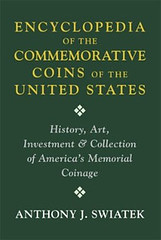 The Encyclopedia of the Commemorative Coins of the United States is written by Anthony J. Swiatek and published in 2012 by KWS Publishers. While many books on commemorative coinage have been released over the years, this volume provides what is perhaps the most comprehensive account available on both the classic series issued between 1892 and 1954 as well as the modern series issued from 1982 to present.
The Encyclopedia of the Commemorative Coins of the United States is written by Anthony J. Swiatek and published in 2012 by KWS Publishers. While many books on commemorative coinage have been released over the years, this volume provides what is perhaps the most comprehensive account available on both the classic series issued between 1892 and 1954 as well as the modern series issued from 1982 to present.
The new encyclopedia starts with a brief introduction to commemorative coinage, written in a language that should be easy to understand for novice collectors but still offer valuable information to even the most experienced collectors. This is followed by discussions of topics such as pricing, grading, collecting, and buying commemorative coins. One interesting topic of note is the area of prooflike commemoratives that spans several pages. This is a relatively neglected area of the commemorative market that has not been discussed in any great deal in books of the past. Swiatek gives some background information on prooflike commemoratives, as well as rarity and pricing. While we cannot be sure if prooflike commemoratives will ever be as popular as say prooflike Morgan Dollars, this is still interesting and valuable information not found elsewhere.
The book then continues with individual listings in chronological format for each of the 59 classic commemorative designs as well as the modern commemoratives and the 50 State Quarter Program.
 Even though the detailed information about the coins is valuable and a large part of the 712 page book, I believe the most important part is the information and photos within the “related material” sections. This material, which includes advertising, packaging and other promotional items, is surprisingly rare and not often encountered. Swiatek does an excellent job of listing all such items that are known to exist, with many high-quality pictures included. Price indications as well as rarity estimates are given for many such items, information that is difficult to find elsewhere in such great detail. For the advanced collector of commemorative coinage, such material might provide another challenge, as often it was discarded and very few such items have survived the test of time. Most collectors will be familiar with the purple frames issued for the coinage of the 1915 Panama-Pacific Exposition; this book proves that there is much, much more of such material that is worth looking into.
Even though the detailed information about the coins is valuable and a large part of the 712 page book, I believe the most important part is the information and photos within the “related material” sections. This material, which includes advertising, packaging and other promotional items, is surprisingly rare and not often encountered. Swiatek does an excellent job of listing all such items that are known to exist, with many high-quality pictures included. Price indications as well as rarity estimates are given for many such items, information that is difficult to find elsewhere in such great detail. For the advanced collector of commemorative coinage, such material might provide another challenge, as often it was discarded and very few such items have survived the test of time. Most collectors will be familiar with the purple frames issued for the coinage of the 1915 Panama-Pacific Exposition; this book proves that there is much, much more of such material that is worth looking into.
Overall, Swiatek's Encyclopedia of the Commemorative Coins of the United States is a valuable addition to any numismatic library. The only drawback might be the price of $150, which even for numismatic literature is quite heavy. I believe, however, that the book surely is worth its cost and should prove to be much more valuable to the collector thanks to all the information and advice it contains. I wholeheartedly recommend this book to anyone with even a modest interest in America’s commemorative coinage.
To read the complete article, see: Book Review: Encyclopedia of the Commemorative Coins of the United States, by Anthony J. Swiatek br/> (news.coinupdate.com/book-review-encyclopedia-of-the-commemorative-coins<-anthony-j-swiatek-1836/)
BOOK REVIEW: ABRAHAM LINCOLN - BEYOND THE AMERICAN ICON
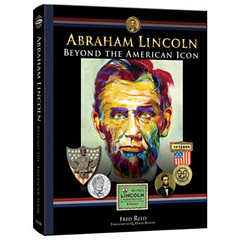 ABRAHAM LINCOLN - Beyond the American Icon
ABRAHAM LINCOLN - Beyond the American Icon
Author Fred Reed
Foreword by Q. David Bowers
Whitman Publishing, LLC, Atlanta, GA, 2013
Reviewed by John and Nancy Wilson, NLG
Abraham Lincoln – Beyond the American Icon by well-known and respected author Fred Reed, with a foreword by Q. David Bowers follows closely on the heels of his 2009 award winning reference Abraham Lincoln: The Image of His Greatness. This 2013 Hardcover reference has 464 pages and over 1400 full color images. The Fred Reed collection contains 4000 Lincoln items, many of which have been reproduced here. The cover of the book has a vivid and very famous image of Abraham Lincoln done by Artist Cathee A. “Cat” Clausen. Quoting Q. David Bowers Foreword, “The present book is indeed comprehensive; it would be a rare find indeed to locate a significant image of Lincoln as a product advertisement, medal, civic monument, or other manifestation not known to the author.”
The Introduction has the author’s thoughts and reflections on Lincoln, other personalities of the time, and highlights from the many different things you will find in the five chapters. We think that you will find a lot of useful information on Lincoln that won’t be found anyplace else. Why would anyone do another Lincoln book and quoting Fred Reed, “Simply put, it is because I still have Abe-eagerness in my sinews, and my publisher thinks our public still has Abe-receptivity, too?” Fred goes on to say, “this new work has entirely new text, and all new illustrations, and the emphasis has shifted. Its predecessor book was more heavily slanted toward Lincoln the man and Lincoln the ideal-the Mythmaking phase of the story. This book is more heavily slanted toward Lincoln the idol and Lincoln the icon-the branding phase.” We especially liked the timelines the author used in all the chapters.
Chapter 1. Abraham Lincoln: 1809 – 1865. From his early years to the day before he was assassinated, this book chronicles the important parts of his life. There are pictures of ephemera, tokens and medals, U. S. Currency & Coins, broadsides, pins, ribbons, stock certificates, tintypes, scrip, cartoons, periodicals of the time, seals, and letters. There is even an illustration of a check Lincoln signed on April 13, 1865, the day before he died.
Chapter 2. Lincoln the Ideal: 1865 – 1909. This chapter chronicles the important events from 1865 to 1909. Many pictures of Lincoln and items used during that period are shown. A Lincoln card was engraved & printed by the Treasury Department in 1866. In 2012 the Bureau of Engraving & Printing produced a Souvenir Card using that same portrait. At the top of the Lincoln card there is a small eagle which was engraved by Henry Gugler. The head of the eagle is turned backwards and when inverted the vignette resembles the head of a jackass. This eagle is on the $10 United States Notes of Series 1869 to 1880. There is also an illustration of NY collector Andrew C. Zabriskie’s 1873 catalog of medals struck honoring Lincoln. Only 75 copies were produced. The 1868 illustration of Alexander Hay Ritchie’s famous engraving of Lincoln’s deathbed scene will also be found in this chapter.
Chapter 3. Lincoln the Idol: 1909 – 1959. 1909 was the centennial celebration of Lincoln and the author covers some of the events and items that were produced including the 1909 (Lincoln’s birth year) Lincoln cent. It was interesting to read that the Lincoln cent idea “was conceived by Lincolnphile Republican U. S. president Theodore Roosevelt as a daily reminder of the nation’s indebtedness to the nation’s savior.” Also quoting the book “As a young boy, Teddy witnessed the Lincoln funeral procession up the city’s Broadway from the window of his grandfather’s mansion.”
One of the more interesting illustrations has an enlargement of the reverse of the Lincoln cent with the name Brenner appearing. The mint stopped the presses and later the initials V.D.B. (Victor David Brenner) were used and his last name disappeared. Many other great illustrations depicting Lincoln are found in comic books and matchbook covers and other items up to gold medals. On January 2, 1959 the U. S. Mint started striking Frank Gasparro’s Lincoln Memorial on the reverse of the cent.
Chapter 4. Lincoln the Icon: 1959 – 2009. “No U. S. presidential portrait in history has been more widely duplicated and dispersed than Anthony Berger’s February 9, 1864, photograph known as O-92, except for the Washington portrait on the dollar bill and the Lincoln profile on the cent.” This O-92 image of Lincoln is prominently illustrated. Sculptor Marcel Jovine was the creator of a rectangular plaque for the 125thanniversary of the American Numismatic Society in 1983. The reverse of Jovine’s medal illustrates the stylized process of reducing Brenner’s Lincoln cent design to coinage-die size. The version depicted was used in 1982 on the obverse of Chet Krause’s aluminum medal marking the 30thanniversary of his weekly coin tabloid, Numismatic News. Many more pages of illustrated collectibles will be found depicting Lincoln. Many of them we would consider available and inexpensive.
This period has several different movies that had Lincoln a part of them. In one of the illustrations you see twenty-third century ship’s captain James T. Kirk (William Shatner) meeting his boyhood idol, 19th century U.S. president Abraham Lincoln, played by Lee Bergere. The chapter covers other movies and plays regarding President Lincoln. In the timeline of events, we found on September 12, 2007 a link to the George Eastman House, Rochester, NY, “the great repository and museum of photographic history, posts a short podcast to YouTube, entitled Abraham Lincoln Plate Negative.” You can learn about the plate and view the podcast at: www.youtube.com/watch?v=LEGcJGXjjT0
Chapter 5. Lincoln the Immortal: 2009 and Beyond. The author states “Old habits die hard in regards to paper money.” Since their appearance on U.S. Paper Money in 1869, Lincoln consistently appeared on notes of $100, $500, $1, and (most famously) $5 bills for a period of 131 years. During the Civil War Lincoln appeared on U. S. fractional currency. Two other photos in this chapter show the author Fred Reed with his first edition of Lincoln at conventions. The timelines of Lincoln events in the chapter end with a February 2012 comment on “The Ford’s Theater Center for Education and Leadership” opened across from the famous Ford’s Theater and next door to the Petersen House.” “Construction for this facility started in July 2010.” If you go to Washington, DC this would be a great place to visit. We think that everyone will enjoy reading this book and viewing the many illustrations in it.
The Notes follow, and the Bibliography will help numismatists, historians and collectors find out sources for their research on Lincoln. About the Author, Photo Credits and the Index close out this finely done book on one of our most popular Presidents.
The Whitman press release said regarding this second Lincoln image book (or sequel) by Fred Reed, “Plus more award-winning analysis and commentary.” We think that any reader of this Lincoln book will appreciate greatly the author’s expertise on the subject of Lincoln. No one could have done this reference better than Fred Reed. The book is a must for any numismatist (collector or dealer), historian, researcher, library or just any person who cares about one of our most famous Americans, “Abraham Lincoln,” – bar none.
The author’s vast knowledge and love of Abraham Lincoln, his great care with detail writing the book, along with his immense collection illustrated throughout make this book an excellent source of information. If you just want the book for yourself or a friend, a coffee table decoration or to use to catalog your collection of Lincoln memorabilia the selling price of $29.50 is a real bargain. We also think this book will be a candidate for book of the year at the NLG function at this year’s ANA World’s Fair of Money. For information on purchasing this reference you can contact: Whitman Publishing LLC, 3101 Clairmont Rd., Suite G., Atlanta, GA. 30329, Phone Number (800) 546-2995 or www.whitmanbooks.com .
BOOK REVIEW: MORE ON ABRAHAM LINCOLN - BEYOND THE AMERICAN ICON
 John and Nancy Wilson have given us a good description of the book and its contents in the previous article. With the assistance of author Fred Reed I'll add a few comments and excerpts and images from the book. To the right is the central cover image, a colorful Lincoln portrait by artist Cat Clausen. It's a great choice as it shows the range of interpretations over the years while remaining instantly recognizable as the visage of our 16th President.
John and Nancy Wilson have given us a good description of the book and its contents in the previous article. With the assistance of author Fred Reed I'll add a few comments and excerpts and images from the book. To the right is the central cover image, a colorful Lincoln portrait by artist Cat Clausen. It's a great choice as it shows the range of interpretations over the years while remaining instantly recognizable as the visage of our 16th President.
From the Foreword by Q. David Bowers:
If anyone is qualified to break new ground in Lincoln scholarship, it is Fred Reed. I have been a friend of Fred’s for many years, since the 1960s in fact, and have followed his award-winning career. A consummate researcher and a gifted writer, he has created standard reference articles and books on several historical subjects, his Abraham Lincoln: The Image of His Greatness being a recent example. Both broad and deep in its scope, that book was recognized with literary awards from national organizations representing several branches of numismatics. Beyond that, it has been embraced by the mainstream of the Lincoln research community, as well as by more casual armchair historians and Lincoln fans.
Now, in his latest work, Abraham Lincoln: Beyond the American Icon, Reed has created a perspective of Lincoln from a new angle: Lincoln seen not from the viewpoint of military history or presidential accomplishments, but as he was regarded by the American public in his time, followed by his legacy since 1865.
In many ways Fred Reed’s new book adds to the appreciation of Lincoln as a human being. In the years after the president’s passing, satire was rare, and appreciation, indeed adulation, was common. For an artist or sculptor to be commissioned to create a statue, plaque, coin, or other item depicting Lincoln was a high tribute.
Reed traces the shift in public opinion that has resulted in occasional contrarian depictions of Lincoln as secretly gay or racist, showing how the once universally revered president has become touched by controversy and parody, and yet endures as one of the most fascinating figures in our collective history.
Lincoln’s image has become so familiar to Americans that the beloved president has been increasingly called upon to serve any number of agendas, from the “Honest Abe” persona that advertisers and business owners appropriate in order to gain credibility and the public’s trust, to the rawboned pioneer scrapper, who is called upon to bodyslam evildoers in graphic novels and films.
From Fred Reed's Introduction:
Abraham Lincoln: Beyond the American Icon gives me an opportunity to amplify and extend on previous commentary; in short, to draw a finer point to the first book’s arguments. It also provides an opportunity to drill down on certain aspects treated cursorily in the first text, and present interesting additional data or details (such as the Henry Clay medal presented by Daniel Ullman to Lincoln, or the City of Lincoln, Nebraska, municipal scrip with Lincoln portraits), and to show interesting different varieties/types of previously illustrated Lincolniana. Furthermore, this book presents the opportunity to put down on the record a broad canvas of celebrations surrounding the Lincoln bicentennial. We might wish that someone had done as much a century ago, shortly after the Lincoln centennial!
 Fig. 1.15. Today we know this famous image, generally credited to Peoria, Illinois, photographer Roderick M. Cole, as O-14. Reproductions of the image were very popular on campaign buttons (ferrotypes) and ribbons during the election of 1860. This print at the Library of Congress supplies this spurious information written in pencil on back: “This is the photograph from the original ambertype [sic] owned by the Latham family of Lincoln, Illinois. It was posed for by Mr. Lincoln at the time the city of Lincoln was named for him. The photographer is unknown and is called the lost ambrotype. [Signed] Gillespie, 7/5/35.” Lincoln, Illinois, was incorporated in 1853. Lincoln photograph historians now believe this likeness was taken circa 1858.
Fig. 1.15. Today we know this famous image, generally credited to Peoria, Illinois, photographer Roderick M. Cole, as O-14. Reproductions of the image were very popular on campaign buttons (ferrotypes) and ribbons during the election of 1860. This print at the Library of Congress supplies this spurious information written in pencil on back: “This is the photograph from the original ambertype [sic] owned by the Latham family of Lincoln, Illinois. It was posed for by Mr. Lincoln at the time the city of Lincoln was named for him. The photographer is unknown and is called the lost ambrotype. [Signed] Gillespie, 7/5/35.” Lincoln, Illinois, was incorporated in 1853. Lincoln photograph historians now believe this likeness was taken circa 1858.
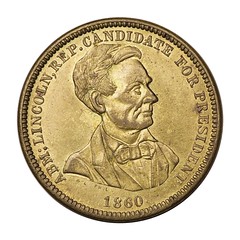 Fig. 1.28. Philadelphia diesinker Robert Lovett, who is also credited with the fantasy “Confederate” cent, created this marvelous campaign token (King-48) for Abraham Lincoln in 1860, proclaiming “Protection to American Industry / Free / Homes / For / Free Men,” both Republican planks. The portrait is an artistic rendering of the Hesler photograph, O-26. It is a 27-millimeter masterpiece. However, its concentric reverse design has only 32 stars, when there were 34 states at the time.
Fig. 1.28. Philadelphia diesinker Robert Lovett, who is also credited with the fantasy “Confederate” cent, created this marvelous campaign token (King-48) for Abraham Lincoln in 1860, proclaiming “Protection to American Industry / Free / Homes / For / Free Men,” both Republican planks. The portrait is an artistic rendering of the Hesler photograph, O-26. It is a 27-millimeter masterpiece. However, its concentric reverse design has only 32 stars, when there were 34 states at the time.
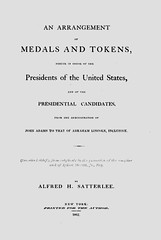 Fig. 1.41. Alfred Satterlee’s privately printed pamphlet An Arrangement of Medals and Tokens, Struck in Honor of the Presidents of the United States was the first publication to quantify and catalog the proliferation of numismatic tributes to Honest Abe.
Fig. 1.41. Alfred Satterlee’s privately printed pamphlet An Arrangement of Medals and Tokens, Struck in Honor of the Presidents of the United States was the first publication to quantify and catalog the proliferation of numismatic tributes to Honest Abe.
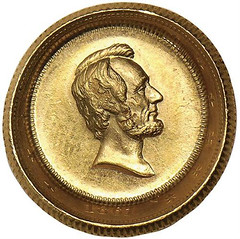 Fig. 2.31. Anthony Paquet was a Philadelphia medalist with a close association to the U.S. Mint, having been an assistant engraver there from 1857 to 1864. He went into private business in Philadelphia but continued to enjoy Mint patronage, producing dies for a great many Mint medals, including the various small cent-sized (19 mm) Abraham Lincoln medals, and the Northwest Sanitary Fair medal depicting Lincoln. Non-Mint strikings using Paquet’s small Lincoln profile die are also known, but this is perhaps the most spectacular, struck over a U.S. $5 gold piece, with a diameter of 21.6 mm. This was most likely done either just after the Civil War or during the Civil War centennial, both times when a great many vintage dies were used to strike collector issues.
Fig. 2.31. Anthony Paquet was a Philadelphia medalist with a close association to the U.S. Mint, having been an assistant engraver there from 1857 to 1864. He went into private business in Philadelphia but continued to enjoy Mint patronage, producing dies for a great many Mint medals, including the various small cent-sized (19 mm) Abraham Lincoln medals, and the Northwest Sanitary Fair medal depicting Lincoln. Non-Mint strikings using Paquet’s small Lincoln profile die are also known, but this is perhaps the most spectacular, struck over a U.S. $5 gold piece, with a diameter of 21.6 mm. This was most likely done either just after the Civil War or during the Civil War centennial, both times when a great many vintage dies were used to strike collector issues.
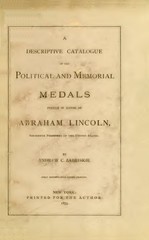 Fig. 2.68. New York collector Andrew C. Zabriskie created the first catalog devoted exclusively to medals struck to honor Abraham Lincoln. Only 75 copies were printed for the author in 1873. Examples are rare today.
Fig. 2.68. New York collector Andrew C. Zabriskie created the first catalog devoted exclusively to medals struck to honor Abraham Lincoln. Only 75 copies were printed for the author in 1873. Examples are rare today.
THE NUMISMATIST CELEBRATES ITS 125TH ANNIVERSARY
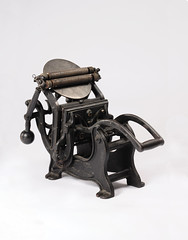
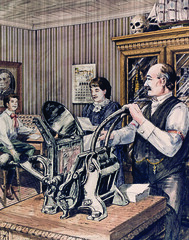
In the autumn of 1888, The American Numismatist, a modest, four-page leaflet dated September-October, debuted. The brainchild of Dr. George F. Heath of Monroe, Michigan, the publication dropped the word “American” from its title on its subsequent issue and The Numismatist officially was born.
The Numismatist continued publication, with the third issue bearing a January-February 1889 date. Perhaps Heath sensed that his small leaflet would be no less relevant 125 years ago than it is today, for he stated in this third issue that “The Numismatist is here to stay.”
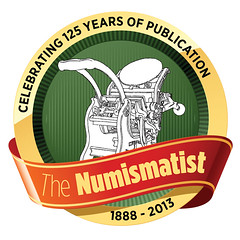 And stay it has. After a two-month demise in 1890, the magazine returned, with 12 issues forecast for that year. The coin-collecting hobby was expanding, and ambitious plans were announced for 1891.
And stay it has. After a two-month demise in 1890, the magazine returned, with 12 issues forecast for that year. The coin-collecting hobby was expanding, and ambitious plans were announced for 1891.
In February 1891, Heath proposed the formation of the American Numismatic Association. His idea was published in an article titled “A Plea for an American Numismatic Association” in the double-sized March issue. For a brief time in the late 1890s, The Numismatist separated itself from the ANA and was no longer its official journal.
Heath died suddenly on June 16, 1908, and ANA President Farran Zerbe, who assumed the position of editor and publisher, soon bought the publication for himself from Heath’s heirs. In 1911, through the generosity of W.C.C. Wilson of Montreal, Canada, The Numismatist was purchased from Zerbe and presented to the ANA. It has been an important part of the American Numismatic Association ever since. (From 2003 to 2007, "The" was dropped from its title.)
Including Heath, 15 chief editors have steered the magazine’s course during the past 125 years. In 2003, Barbara Gregory, the first woman to fill that position, took The Numismatist to a new, full-color format, which was refreshed in 2011.
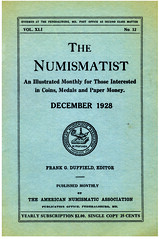
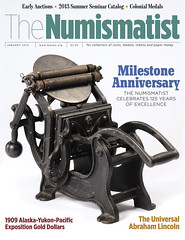
The December 1928 and January 2013 issues
Today, George Heath’s humble little leaflet has evolved into a premiere hobby publication that arrives in thousands of ANA members’ mailboxes each month. (The magazine, as well as archived editions, also is available online to ANA members.) George Heath would be proud.
The ANA asks for your help as it endeavors to unite collectors, grow the hobby and expand the value of membership. Your tax-deductible gift of $25, $50, $100 or more to this year’s Annual Giving Campaign will allow the Association to bolster its role as a positive force and leader in the numismatic community.
 To thank donors for their generosity, the ANA has produced a limited-edition reprint of the very first issue of The Numismatist.
To thank donors for their generosity, the ANA has produced a limited-edition reprint of the very first issue of The Numismatist.
This exclusive publication will be available only in 2013 to life members and those who give $50 or more. Once it’s gone, no more copies will be produced. Watch for the ANA Annual Appeal in your mailbox, or go to www.money.org/ membership/donate .
For more information on the ANA, see: www.money.org
To read an earlier E-Sylum article on anniversaries, see: VOCABULARY ANSWER: QUASQUICENTENNIAL (www.coinbooks.org/esylum_v04n08a08.html)
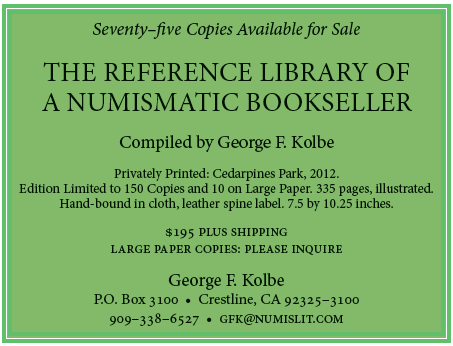
ON THE 'FIRST' 1794 DOLLAR
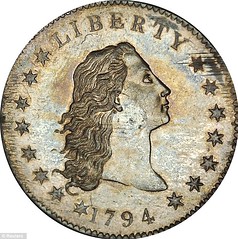 Sorry, but how does anyone know that the 1794 dollar that went for ten
million was actually the first one struck? It strikes me that we are moving
from the realm of numismatics into that of theology in this case. There's
enough hot air and hype in this branch of numismatics as it is (e.g.,
grading a VF-20 coin as AU-55 just because it happens to be an early
American issue). To definitively state that one particular piece is the
first of 1,758 struck doesn't help matters.
Sorry, but how does anyone know that the 1794 dollar that went for ten
million was actually the first one struck? It strikes me that we are moving
from the realm of numismatics into that of theology in this case. There's
enough hot air and hype in this branch of numismatics as it is (e.g.,
grading a VF-20 coin as AU-55 just because it happens to be an early
American issue). To definitively state that one particular piece is the
first of 1,758 struck doesn't help matters.
1) I note that it's graded Specimen-66 by the Professional Coin Grading Service (PCGS).
2) A 'specimen' coin is meant for presentation rather than circulation. Let's leave the grade aside: like proofs, specimens are distinguished by their mode of production, not their numerical grade.
3) BUT it is noted that this piece, like a few other dollars of that and the following year, had a silver plug inserted in the center, to bring it up to full federal standards. Why would you do that for something that was never intended for circulation anyway?
4) AND those adjustment marks on the obverse: early coiners attempted to bring the weight of a planchet or coin within official tolerance, filing the piece down if it was too heavy, tossing it back in the melting pot if it was too light. From the evidence presented by the obverse of this coin, its weight was adjusted downward while still in the planchet stage. But again, if it were intended as a specimen, why not leave the surface alone and eat the few cents' loss on the metal with the goal of Making Numismatic History?
~j'reste mah case.
I can agree with Dick that the adjustment marks are unlikely to be found on a true specimen coin. But I asked, "Couldn't someone argue that the coin was plugged and filed to meet the legal requirements set by Congress? Why shouldn't a specimen adhere to the same standards? -Editor
Dick responds:
As for the plug (or for that matter, the adjustment marks), the plug might have been a sincere attempt to bring the thing into legal conformity; but specimens (and proofs) would, I assume, have had a certain time constraint as to when they must be finished and out the door ("See here, we promised the Prince his coin would sail next Thursday on the packet, and it will, perfect weight or not!"). Human nature being what it is, I don't see early Mintmasters being any more professional than their modern counterparts. But the kicker, for me, is the adjustment marks on the upper-right portion of the obverse. NO Mintmaster worth his salary would have ever intended that coin as a specimen strike, or remitted it as such.
The coin, known as the Flowing Hair Silver Dollar, sold for a record $10 million last week at auction.
“It’s one of the rarest coins in existence,” said Laura Sperber, co-partner of Legend Numismatics of Lincroft, which purchased the coin. “Who knows who could have held this coin? George Washington? Any of the Founding Fathers?”
To read the complete article, see: Rare silver dollar sold for $10 million to Jersey firm (www.nj.com/business/index.ssf/2013/01/rare_silver_dollar_sold_for_10.html)
Alan V. Weinberg writes:
Now we know Laura Sperber's rationale for her outrageous bidding tactic. Interesting reading.
A month out we were ready to buy it at $10 million dollars all in. Then "auction fever" set in. We heard rumors, we started to evaluate potential bidders, we began feeling the pressure that $10 million for this iconic coin would not be enough. After all, how many chances will there ever be to buy a classic coin like this?. In an auction setting, anyone could pop up for it. The market has dramatically changed since it had been offered for sale in 2010. Classic rarities are in demand and are circling the numismatic universe in their own orbit. So we decided to raise our bid.
Then last week, the Batmobile sold for nearly $5 million dollars. Then we read about some paintings that just sold for $100,000,000.00+. Those events were critical. We rationalized, about what money is really worth (how much the gov. is printing too) and how people perceive value and are spending on it on non traditional assets these days. At that point we realized the 1794 was a tragic oversight to be valued at anything LESS then $10,000,000.00. We raised our limit to $15 million and started to sweat what the other buyers would do. Knowing there was at least one buyer who has coveted this coin forever and had the means to buy it, made us lose lots of sleep last week.
Two days before the sale our lead partner made the final decision, we MUST pay $10 million dollars all in MINIMUM. We developed a 'shock and awe" plan. We were all in agreement, we even went through a mini practice.
The next two days we were all nervous wrecks. We tried to put on our best poker faces about bidding. Everyone in the dealer community pretty much expected us to be bidders. But we tried to hide our plans as best we could.
On the day of the sale we all woke up sick-nerves were getting the best of all of us. It was not until we actually got to NYC-in the auction room itself we felt better. But, with every well dressed person who entered the room, we panicked-OMG, they could out bid us on the dollar! How any of us survived without having a heart attack is a wonder. So we all spoke on the phone and our last minute discussion involved implementing "shock and awe". After sitting thru 93 lots of incredible coins in at total fog, the time had come. We all started to hold our breath.
The auctioneer looked around to make sure she had a clear sightline of all potential bidders. We freaked slightly when we saw the head of a major coin company get ready to bid-we didn't add him to our equation. Oh no! Then the bidding started at $2.2 million. It slowly climbed to $5 million. That was our original planned “shock and awe” point to take control of the bidding hopefully freezing out other buyers. Instead in the fog of bidding, we suddenly got hit at $5.5 million (missing our $5 million dollar invoke). We knew we could not wait any longer, we invoked "shock and awe" and jumped the bid to $8,525,000.00.
EVERYONE in the room was stunned. We firmly believe we took control of the bidding at that point and made a powerful statement about what it will take to beat us. Then for what seemed like the longest close to any lot ever (only because of the stress and lack of breathing) we had done it! We purchased the 1794 $1.00-now more than solidified as the worlds most valuable coin. On the phone and at our table (if you were there) you probably heard the biggest sigh of relief ever. Our strategy had worked! We later confirmed there was at least one bidder right under us. Whew!
The purchase of the 1794 $1 was now history!
To read the complete article, see: 1794 $1 10,016,875.00 THE WORLDS MOST VALUABLE COIN-AND WE BOUGHT IT! (www.legendcoin.com/cgi-bin/inventory/cms2.pl?page=market_report&article=307)
To read the earlier E-Sylum article, see: 1794 DOLLAR SALE COVERAGE (www.coinbooks.org/esylum_v16n04a12.html)
WALTON 1913 LIBERTY NICKEL TO BE AUCTIONED IN APRIL 2013

A humble 5-cent coin with a storied past is headed to auction and bidding is expected to top $2 million a century after it was mysteriously minted.
The 1913 Liberty Head nickel is one of only five known to exist, but it's the coin's back story that adds to its cachet: It was surreptitiously and illegally cast, discovered in a car wreck that killed its owner, declared a fake, forgotten in a closet for decades and then found to be the real deal. It all adds up to an expected sale of $2.5 million or more when it goes on the auction block April 25 in suburban Chicago.
"Basically a coin with a story and a rarity will trump everything else," said Douglas Mudd, curator of the American Numismatic Association Money Museum in Colorado Springs, Colo., which has held the coin for most of the past 10 years. He expects it could fetch more than Heritage Auction's estimate, perhaps $4 million and even up to $5 million.
"A lot of this is ego," he said of collectors who could bid for it. "I have one of these and nobody else does."
The sellers who will split the money equally are four Virginia siblings who never let the coin slip from their hands, even when it was deemed a fake. A North Carolina collector, George O. Walton, purchased one of the coins in the mid-1940s for a reported $3,750. The coin was with him when he was killed in a car crash on March 9, 1962, and it was found among hundreds of coins scattered at the crash site. One of Walton's heirs, his sister Melva Givens of Salem, Va., was given the 1913 Liberty nickel after experts declared the coin a fake because of suspicions the date had been altered. The flaw probably happened because of Brown's imprecise work casting the planchet — the copper and nickel blank disc used to create the coin.
"For whatever reason, she ended up with the coin," her daughter, Cheryl Myers, said.
Melva Givens put the coin in an envelope and stuck it in a closet, where it stayed for the next 30 years until her death in 1992.
Finally, they brought the coin to the 2003 American Numismatic Association World's Fair of Money in Baltimore, where the four surviving 1913 Liberty nickels were being exhibited. A team of rare coin experts concluded it was the long-missing fifth coin.
To read the complete article, see: Sometimes a nickel is worth millions (www.nbcnews.com/business/sometimes-nickel-worth-millions-1C8160610)
MONTAGNE: The nickel - with Lady Liberty on one side and the Roman numeral for V on the other, bears the date 1913. The only problem, the liberty head was replaced by the buffalo head in 1912, making this nickel a bootleg - one of five allegedly cast at the Philadelphia Mint by a crooked employee out to make some quick coins.
INSKEEP: If only he'd been able to hold on to it for a century. But this fraud was no fool. He did wait until the statute of limitations expired in 1920 to sell the set and he did get a pretty penny at that time, which is about to happen again.
To read the complete article, see: Rare Nickel Expected To Sell For A Pretty Penny (www.npr.org/2013/01/29/170530165/the-last-word-in-business)
GEORGE WALTON PHOTO IDENTIFICATION

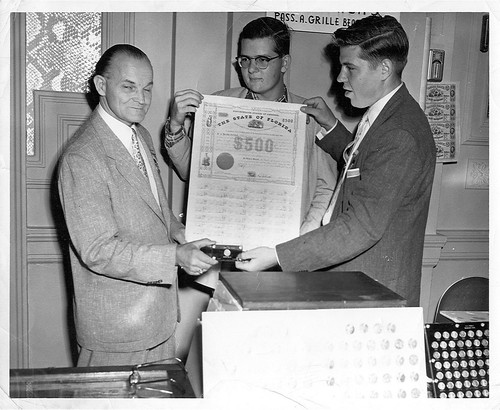
Dave Alexander writes:
I am guessing that the group photo may be Walton with the leaders of the Blue Ridge Numismatic Association The group of three is more explicable, however. Note the name "Pass.a.Grill Beach" on the wall!. The lad on the right is the young Grover C. Criswell, soon to be "the youngest elected mayor in the U.S." The Florida Gulf town was later renamed Saint Petersburg Beach
Tom DeLorey writes:
The person on the right in the second Walton photo looks like a young Grover Criswell. Considering the Florida bond they are holding up, this seems plausible.
Ken Bressett writes:
I am pretty sure that the man on the right in the second photo is Grover Criswell, Jr . And I suspect that this was taken sometime around 1955.
Dennis Forgue writes:
The George Walton photo has Clarence (center) and Grover Criswell (right) in the photo The wall sign behind Pass-A-Grill (Florida) is where the Criswell’s lived and Grover was later Mayor, and the Criswell Money Museum was located there.
To read an article by Fred Reed on the Criswells in Coins Magazine, see: The Richest Man in Confederate Money (numismaster.com/ta/numis/Article.jsp?ad=article&ArticleId=7819)
To read the earlier E-Sylum article, see: GEORGE WALTON PHOTO IDENTIFICATION SOUGHT (www.coinbooks.org/esylum_v16n04a10.html)
A THEORY ON THE 1811-DATED "OIE DIOE" TOKEN
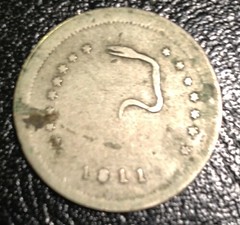
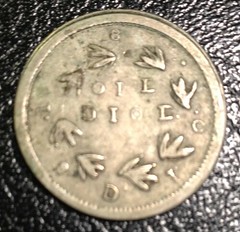
From Budapest Dave Hirt writes:
I have been following the story on John Kraljevich's 1811-dated "DIOE" token. Great buy John - congratulations. It is interesting how numismatic items lost for years turn up again. I wish I was at home to check my JNT Levick sale of May, 1884 to see if that token was there. When it came to tokens, that sale had everything, and to see how W E Woodward cataloged it.
Dave Lange writes:
I should have written last week, but I waited to see what others would say about John Kraljevich's token. Since no one had an opinion, I'll throw out mine.
The style of the leaves and some of the letters/numerals look very similar to what I've seen many times on California fractional gold pieces of Periods 2 and 3. It may be that this token was just a trial piece made by some late-19th Century die sinker to test his punches. The 1811 date would thus be fictitious, too.
Bob Leonard writes:
I don't believe that there is the least connection between this dime-size item and the gold dollar-size and smaller California gold pieces. I agree with Henry Chapman that it is of the 1835-1840 period because of the German silver/Feuchtwanger composition. Since it is dime size, I take the inscription to be intended for ONE DIME, either very badly punched in or deliberately blundered to avoid problems with the Treasury Department after the suppression of Hard Times tokens in 1838.
Perhaps the snake and 1811 is a tavern sign, which would be recognized by its patrons. If this token is ever to be attributed, we will need to find what part of the country (as exactly as possible) it comes from. Rural New York is a good place to start.
To read the earlier E-Sylum article, see: MORE ON THE 1811-DATED "OIE DIOE" TOKEN (www.coinbooks.org/esylum_v16n04a15.html)
THE BOOK BAZARRE
NOTES FROM E-SYLUM READERS: FEBRUARY 3, 2013
Alan Herbert, Olin Brass and a Mint Security Breach
Bruce W. Smith writes:
I saw Alan Herbert from time to time when he passed through the Krause Publications office when I worked there (1974-77). Not long after I started working there, when the company was in the old building downtown by the lake, Alan was talking to someone at the desk next to mine. I overheard him say something about how he couldn't understand why there were so many U.S. error coins, including blank planchets for all denominations, coming on the market at that time.
Though I did not collect U.S. coins, nor error coins, I interrupted to say I knew the answer to that question. At that time Olin Brass in Alton, Illlinois, across the river from my hometown of St. Louis, was making all the planchets (or perhaps the coinage strip) for the U.S. mints. All the error coins detected at the mint, apparently including blank planchets, were shipped back to Olin for remelting. When the bins left the mint, they were under guard, but when they arrived at Olin, they were just scrap metal. Employees would grab a handful when they passed by the bins and take them home.
I learned this from a collector/dealer who lived in Alton, when he offered me a set of blank planchets -- penny through half dollar. When I mentioned this to Alan, he was shocked. He immediately grabbed a telephone and called the mint to alert them to this security breach
Dave Hirt's Hobo Nickel
Dave Hirt writes:
I was sorry to read of the passing of Alan Herbert. He seems to have had a wonderful life. He was a great numismatist!
Reading in the last couple of issues about the Hobo nickel reminded me that I have owned one for years. I received it in circulation sometime in the late 1940's or early 1950's while making my weekly collections for the newspaper on my paper route. I had no idea what it was, but kept it. Someone that I showed it to told me it was a "Jew nickel". It was not until years later after I subscribed to Coin World that I found out what it really was.
To read the earlier E-Sylum article, see: ARTICLE PROFILES $24,000 HOBO NICKEL BUYER CHRIS DEMPSEY (www.coinbooks.org/esylum_v16n04a11.html)
January 2013 Issue of Moneta Published
Serge Pelletier writes:
Happy New Year on behalf of the Ottawa Numismatic Society! The January 2013 issue of moneta, the journal of the Ottawa Numismatic Society in now available at www.ons-sno.ca.
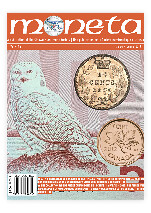 In this issue:
In this issue:
- A type collection of Canadian 10-cent pieces (Part 1) [Steve Woodland]
- - 2012: An unparalleled year for Canadian numismatics [Serge Pelletier]
- - Topical Collecting: Winter [Serge Pelletier]
- - When was a York shilling? [Dr. Chris Faulkner]
And more. Happy reading!
To read the current issue, see: www.ons-sno.ca/Moneta_CURRENT_PV.pdf
2x2 holder with the square window sought
John Mutch writes:
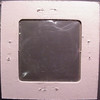 I am in need of a supply of this type of 2x2 holder with the square window. Over the years I have received an assortment of tokens in this type of holder, but have been unable to determine what company made them and when. "Before my time" is the usual answer I get. Presumably they are no longer made, but if one of our readers has a supply of the ones with the Dollar-size window that they would be willing to sell, I'd be most grateful.
I am in need of a supply of this type of 2x2 holder with the square window. Over the years I have received an assortment of tokens in this type of holder, but have been unable to determine what company made them and when. "Before my time" is the usual answer I get. Presumably they are no longer made, but if one of our readers has a supply of the ones with the Dollar-size window that they would be willing to sell, I'd be most grateful.
Postcard of the Traveling Liberty Bell
Tom Casper writes:
The article in last week's E-Sylum about the Traveling Liberty Bell mentioned this event was recorded on postcards. I have one of those postcards from when the Liberty Bell visited Milwaukee, WI. The postcard is undated but it is undoubtedly from 1915 while it was en route to the Pan-Pac Expo in San Francisco.
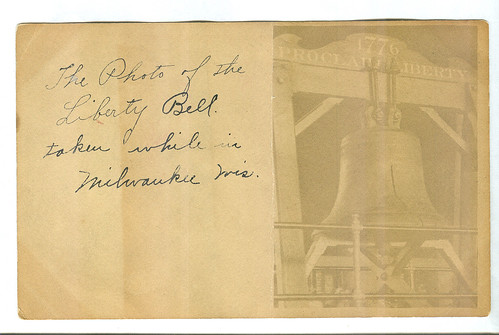
To read the earlier E-Sylum article, see: NOTES FROM E-SYLUM READERS: JANUARY 27, 2013: The Traveling Liberty Bell (www.coinbooks.org/esylum_v16n04a08.html)
Article Discusses Costs and Quantities of Royal Mint Coins
Philip Mernick writes:
On pages 14 & 15 of Thursday’s Metro Newspaper there is a good article on the cost of making coins and the quantities in circulation.
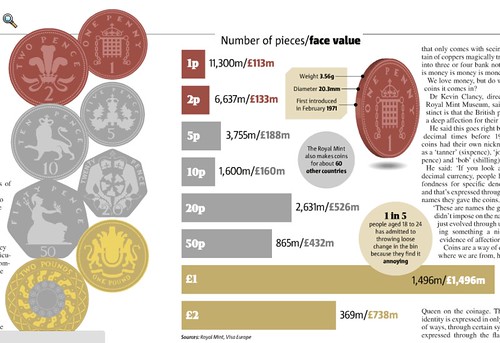
To read the complete issue, see: e-edition.metro.co.uk/2013/01/31/
California gold in the Mendes I. Cohen Sale
Dave Stone writes:
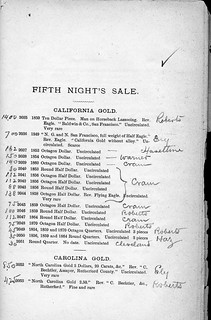 Attached is a scan of the California gold in the Mendes I. Cohen Sale (Edward Cogan, 10/1875). I hope this helps Bob Leonard in his research. The update of the Breen-Gillio book was great.
Attached is a scan of the California gold in the Mendes I. Cohen Sale (Edward Cogan, 10/1875). I hope this helps Bob Leonard in his research. The update of the Breen-Gillio book was great.
It was very instructive to see the account of the sale in the Coin Collector’s Journal that Rick Stroman sent in. It looks like they just covered the copper 1792 disme pattern in lot 378, skipping the silver disme in lot 379, which sold to “Roberts” (Fonrobert). They probably considered the coin damaged, and therefore less interesting, because the date was effaced.
To read the earlier E-Sylum article, see: COIN COLLECTOR'S JOURNAL ARTICLE ON 1875 COHEN SALE (www.coinbooks.org/esylum_v16n03a10.html)
NEW TECHNOLOGY CREATES NUMISMATIC ITEMS IN 3D
Get ready for a revolution in numismatic book publishing! Not only can your manuscripts be illustrated in color, but also in three dimensions!
Numismatic items can now be easily replicated, reproducing the relief the same height as original coins and medals and apply this to pages in a book. One machine, the Solidoodle, costs only $399, intended for desktop publishing for home use. Or for $350 you can obtain a kit to build your own to attach to your computer. These are about the size of an old 18-inch TV.
The technology is to add layers of material on top of each other in the shape controlled by the computer. By continuing to add layers it builds up to the height of the original. The material is usually plastic, but it can also be metal, ceramic, or even chocolate!
To add color it needs to be Pad Printed by another technology. I predict the two technologies will soon be merged in the future. Viola! You can have coin and medal images in color with realistic relief. Imagine numismatic books produced with such an innovative technology. It is cutting edge technology at present but with sustained demand in the future this could be developed into common used for future numismatic books.
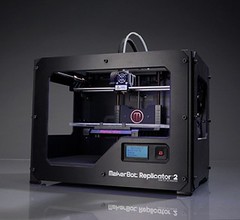 The present Pad printing technology is a German invention and these machines cost over $10,000. The best 3D machines so far, a MakerBot Replicator II, is a Dutch invention which costs $2,200.
The present Pad printing technology is a German invention and these machines cost over $10,000. The best 3D machines so far, a MakerBot Replicator II, is a Dutch invention which costs $2,200.
Present limitation for Pad printing is an item less than 60mm, about 57mm would be about the largest item to be imaged in color. It could certainly print on the plastic even in relief. The Pad printer applies five separate colors -- or black and four colors similar to a color photocopier -- to the pad and this is impressed against the relief image and deposits all colors at once..
The result would not be different from embossed color printing first created in the 1890s in Austria. Publisher Alfred Joseph Blumel produced post cards of coins of the world. These were printed in color first on card stock, then impressed with embossing dies to achieve the relief images. His coin illustrations were current coins in circulation by countries.
He then gathered all these country coin images together in a bound book and dedicated this to the president of the United States. I guess he thought this would bring him the fame he sought for this innovation, but nothing much in the numismatic field was done after that. Embossed post card, however, became popular all throughout the 20th century
I am somewhat of a numismatic futurist. I see trends evolving in our modern world and project how these could be applied to numismatics. Therefore I see numismatic books published in the future with illustrations in realistic exact color in raised relief. I just cannot say when this will happen. Stay tuned to E-Sylum. It will be announced here first.
Here is what has been discussed in The E-Sylum about Blumel's coin cards: www.coinbooks.org/esylum_v16n04a03.html
The Dutch firm that manufactures Makerbot Replicator has opened a retail store in New York City. Here is an article in the Christian Science Monitor: www.csmonitor.com/Innovation/Tech/2012/1109/MakerBot-Replicator-2-Print-your-own-objects-at-home
I hadn't considered the feasibility of 3D numismatic illustrations. I'm not sure if that would be economically viable for an entire book, but I could see some key illustrations being done this way. Or, perhaps, one could go online and download coin image files and print examples on a personal 3D printer.
The most common medium is plastic, but 3D printing has been done experimentally in various media. Some scientists believe we could be within ten years of printing replacement human organs. Could we one day print realistic replicas of rare coins as well? Time will tell. "Computer - 1794 Dollar, Specimen-66, with an adjustment mark at 10 o'clock". -Editor
ANS RETRIEVES ANOTHER 7,291 HUNTINGTON COINS
Thanks to a second anonymous donor, the ANS has now retrieved a total of about 26,500 of nearly 38,000 Spanish coins and tokens that had resided at the ANS since 1949 on long-term loan but had been removed by their owner, the Hispanic Society of America, for disposal at a sealed-bid auction at Sotheby’s last March. That sale took place despite provisions in the trust indenture of the HSA’s founder/donor, Archer Huntington, that appeared to prohibit such dispersals of his HSA benefactions.
Purchased by a friend of the ANS (with the help of Alain Baron of Numismatica Genevensis SA, a Geneva coin dealer), the 7,291 new arrivals—5,923 bronze and silver tokens (ca. 1300-1800) from various European countries and 1368 ancient bronze coins from Spain, pre-Roman period—join about 19,000 other ex-HSA coins that were purchased and placed on long-term loan to ANS by another benefactor.
“I am overjoyed that the Society has two good friends who realized the importance of saving as much as possible of this collection for the public,” said the ANS’s executive director, Ute Wartenberg Kagan, who has made it her mission to get the coins back. “We will do our best to honor Archer Huntington’s intention of keeping and publishing his amazing collection of coins.”
The ANS’s staff has already put the previous arrivals—some 19,000 coins—in their original boxes and updated the collection’s computer records. The ANS reports that “an ongoing program of photographing all Huntington coins is underway, and almost 2,000 digital records of coins have been added to the ANS’s database of the Huntington collection. Thanks to the generosity of the two donors, the Society will have sufficient funds to ultimately create an online complete catalogue of all available Huntington coins.”
A group of ex-Huntington coins will be sent by the ANS to the French town of Auriol for an exhibition of the Auriol Treasure, a famous trove of more than 2,100 Archaic silver coins that was discovered in 1867.
To read the complete article, see:
News Flash: American Numismatic Society Retrieves Another 7,291 Ex-Huntington Coins (plus a visit to “Brutus” at the Met)
(www.artsjournal.com/culturegrrl/2013/01/news-flash-american-numismatic-society
-retrieves-another-7291-ex-huntington-coins-plus-a-visit-to-brutus-at-the-met.html)
QUERY: INFORMATION ON KRUPP MINTING EQUIPMENT AND COINS SOUGHT
Bruce W. Smith writes:
I wonder if any of our readers know of any books or articles about the coins, dies and minting equipment made by the Krupp company in Germany? Krupp is best known for its production of artillery and ships, but during most of the 19th century they also made minting equipment and dies, and they actually struck coins for some countries.
They produced the Italy 20 centesimi of 1894 using a KB mintmark (for Krupp Berlin). It has also been said that their Austrian factory struck the China 1936 nickel coins with "A" mintmark, though I have not been able to confirm this. This firm also produced machinery for the U.S. Mint in 1837.
I have found online some books about the Krupp company in general, including: "Alfred Krupp: A Sketch of His Life and Work" (1888) by K. W. Michaelis and Victor Niemeyer (available in reprint); and "Krupp: A History of the Legendary German Firm" by Harold James, Princeton University Press, 2012. But what has been published from a numismatic perspective?
CARNEGIE HERO MEDAL TO FEATURE ON PAWN STARS TV SHOW
 American Numismatic Association member Greg Schenewerk and his bronze Carnegie Medal for Heroism are ready for their close up. When both appear on an upcoming episode of The History Channel's popular series "Pawn Stars," the ANA's Summer Seminar will be the likely beneficiary of the taping.
American Numismatic Association member Greg Schenewerk and his bronze Carnegie Medal for Heroism are ready for their close up. When both appear on an upcoming episode of The History Channel's popular series "Pawn Stars," the ANA's Summer Seminar will be the likely beneficiary of the taping.
It all started when Greg picked up the bronze medal in a Bakersfield, Calif., pawn shop. The back of the medal Greg purchased is inscribed to "John L. Bell/who helped to save/Arthur E. Rivers/from drowning/Swansboro, N.C./August 13, 1931."
The Carnegie Hero Fund Commission issues medals to people who perform heroic acts in civilian life and provides financial help to those disabled because of their heroism. Steel baron Andrew Carnegie started the fund after hearing inspiring rescue stories following a mine disaster that killed 181 people. Since the fund's inception in 1904, there have been more than 9,500 honorees. The medals have become popular collector items.
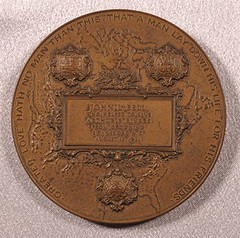 While in Las Vegas last November, Greg stopped by the Gold and Silver Pawn Shop made famous by the TV series. He
showed the Carnegie medal to an employee, who took it to the back of the shop to let owner Rick Harrison examine it. Returning with the medal, the employee took a picture of it and told Greg that she would pass along information to
producers at The History Channel.
While in Las Vegas last November, Greg stopped by the Gold and Silver Pawn Shop made famous by the TV series. He
showed the Carnegie medal to an employee, who took it to the back of the shop to let owner Rick Harrison examine it. Returning with the medal, the employee took a picture of it and told Greg that she would pass along information to
producers at The History Channel.
"I got the call the next day," said Greg, a professional photographer who lives in San Diego.
To read the complete article, see:
STAR TURN: ANA MEMBER TO APPEAR ON PAWN STARS
(www.money.org/blog/posts/2013/january/29/star-turn-ana-member
-to-appear-on-pawn-stars.aspx)
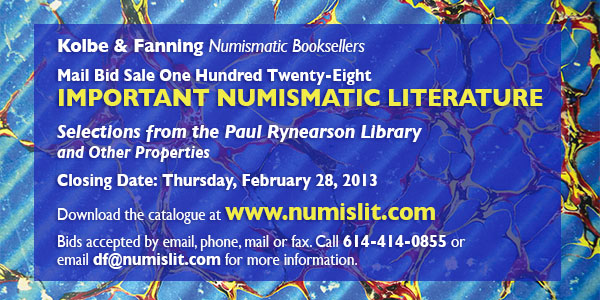
1888 AUSTRALIAN SETTLEMENT MEDAL BY WILLIAM JOSEPH AMOR

With Australia Day celebrations almost upon us, it’s timely to examine this 1888 medallion marking the centenary of the arrival of British settlers in Sydney Cove on 26 January 1788.
Housed in our historic collection, it was sent to Perth from Sydney on the closure of the Mint there in 1926. Struck in bronze, silver and gold, these medallions were made on behalf of the Government of New South Wales which distributed them to “prominent citizens”.
Contrary to assumption, however, it was not the Sydney Mint that created them.
Die engraver William Joseph Amor founded his company in George Street, Sydney in 1888. Learning his craft under English medallists J.S. and A.B. Wyon and later working in Paris, he was en route to America when he was persuaded by Robert Hunt, Deputy-Master of the Sydney Mint, to stay and start his own business.
Marrying the daughter of the Chief Engineer of the Sydney Mint, his association clearly ran deep.
The medal’s obverse portrays a familiar Australia/Britannia seated with a sailing ship and lighthouse in the background. The word ‘Australia’ appears above the main image; beneath it can be seen the initials GR (George III – reigned 1760-1820) separated by a crown, and the historic date of the settlers’ arrival.
The reverse depicts the Arms of New South Wales within a wreath of native flora headed by a crown and the monogram VR. The motto ORTA RECENS QUAM PURA NITES translates to recently risen how bright thou shineth.
Confirmation of the medal’s maker can be found on close inspection of the obverse rim at approximately 7 o’clock.
This medallion was one of the very first to be crafted by Amor’s company, which became Sydney’s major medallist and die-sinker for over century thanks to its ability to meet demand for locally produced, high-quality commemoratives and insignia such as this.
To read the complete article, see:
Australian centenary medal marks rise of famous Sydney medallist
(blog.perthmint.com.au/2013/01/25/australian-centenary-medal-marks-rise
-of-famous-sydney-medallist/)
MARK TWAIN'S THE £1,000,000 BANK-NOTE
Those two old brothers had been having a pretty hot argument a couple of days before, and had ended by agreeing to decide it by a bet, which is the English way of settling everything.
You will remember that the Bank of England once issued two notes of a million pounds each, to be used for a special purpose connected with some public transaction with a foreign country. For some reason or other only one of these had been used and canceled; the other still lay in the vaults of the Bank. Well, the brothers, chatting along, happened to get to wondering what might be the fate of a perfectly honest and intelligent stranger who should be turned adrift in London without a friend, and with no money but that million-pound bank-note, and no way to account for his being in possession of it. Brother A said he would starve to death; Brother B said he wouldn't. Brother A said he couldn't offer it at a bank or anywhere else, because he would be arrested on the spot. So they went on disputing till Brother B said he would bet twenty thousand pounds that the man would live thirty days, anyway, on that million, and keep out of jail, too. Brother A took him up. Brother B went down to the Bank and bought that note. Just like an Englishman, you see; pluck to the backbone. Then he dictated a letter, which one of his clerks wrote out in a beautiful round hand, and then the two brothers sat at the window a whole day watching for the right man to give it to.
They saw many honest faces go by that were not intelligent enough; many that were intelligent, but not honest enough; many that were both, but the possessors were not poor enough, or, if poor enough, were not strangers. There was always a defect, until I came along; but they agreed that I filled the bill all around; so they elected me unanimously, and there I was now waiting to know why I was called in.
To read the complete Mark Twain story, see: The £1,000,000 Bank-Note (www.eastoftheweb.com/short-stories/UBooks/MilPou.shtml)
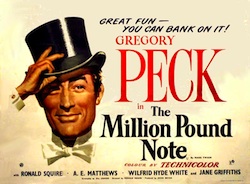 The Million Pound Note (released as Man with a Million as well as Big Money in the U.S.) is a 1954 British comedy, directed by Ronald Neame and starring Gregory Peck.
The Million Pound Note (released as Man with a Million as well as Big Money in the U.S.) is a 1954 British comedy, directed by Ronald Neame and starring Gregory Peck.
To read the complete article, see: The Million Pound Note (en.wikipedia.org/wiki/The_Million_Pound_Note)
To read the earlier E-Sylum article, see: BRITAIN'S 1M AND 100M POUND BANKNOTES (www.coinbooks.org/esylum_v16n04a22.html)
HARVEY STACK ON THE GREAT COIN AUCTIONS OF 1954
 As coincidence would have it, a number of great numismatic collections entered the auction scene in 1954. The collection which received the most pre-sale publicity was the Palace Collection, that of King Farouk of Egypt. King Farouk was a ruler who spent money recklessly on palaces, food, women and partying as well as collectibles including jewels, art and coins at a time when most of his people lived in great poverty.
As coincidence would have it, a number of great numismatic collections entered the auction scene in 1954. The collection which received the most pre-sale publicity was the Palace Collection, that of King Farouk of Egypt. King Farouk was a ruler who spent money recklessly on palaces, food, women and partying as well as collectibles including jewels, art and coins at a time when most of his people lived in great poverty.
King Farouk was forced to abdicate, exiled to Europe, and his coin collection was confiscated by the new government and consigned to auction. Well known London dealer Fred Baldwin of A.H. Baldwin & Co. was entrusted to sell the holdings, which included an extensive collection of ancient and world coins as well as an immense cabinet of United States gold, silver and copper.
Joseph Stack and Morton Stack offered to assist Baldwin & Co. in preparing the U.S. portion of the catalog. Inasmuch as Egypt insisted that the coins must remain in Cairo and with the country of Egypt still in political turmoil, the U.S. State Department advised all U.S. citizens not to travel to Egypt in late 1952 and 1953 and the sale was to be held in 1954. The Stack brothers decided not to go to Egypt as catalogers, but began to assemble funds to be active buyers.
While the Stack’s waited for the sale of the Palace Collection to take place, they received a series of calls offering them several major collections for outright purchase. One was the Davis-Graves Collection from Massachusetts and the other was the Anderson-Dupont Collection from Connecticut. Joseph and Morton went to see the collections and were amazed at how extensive each was. They bought the collections outright in late 1953, which consumed the funds they had set aside for Egypt. But their feelings were “a bird in the hand …”
The Davis-Graves Collection included a wonderful collection from half cents to $20 gold double eagles, with a complete set of $2.50 quarter eagles, 1796 to 1929, an extensive holding of $5 half eagles, an unparalleled set of $10 eagles. The silver and copper coins included a superb collection of silver dollars, including the R. Coulton Davis 1804 silver dollar. The collection was sold in a two-part sale in April and May 1954.
The Anderson-Dupont Collection included, among other things, one of the most extensive and important sets of large cents sold in the mid 20th century. The collection was so important that Dr. William H. Sheldon, the dean of U.S. large cents and author of the then current book on the denomination, offered to research and catalog the collection for Morton Stack, and be reimbursed by the use of the new found information and photographs in the revised edition of his book, Penny Whimsy. It was a record shattering auction which Stack’s conducted in September 1954.
To read the complete article, see: Remember When: 1954 – A Year Of Great Auctions (stacksbowers.com/Blogs/remember-when-1954-year-of-great.html)
MORTON & EDEN TO SELL DUPLICATE 1859 U.S. PROOF SET
Philip Mernick writes:
Morton & Eden are to sell some U.S. coins from the Royal Mint collection. It's ultra rare for the Royal Mint Museum to sell anything from its collection, but this is to fund further purchases.
 Morton & Eden have great pleasure in announcing the sale of important US Proof coins which have remained in the collection of the Royal Mint Museum since their acquisition in 1859.
Morton & Eden have great pleasure in announcing the sale of important US Proof coins which have remained in the collection of the Royal Mint Museum since their acquisition in 1859.
Originally presented by Professor J.H. Alexander of Baltimore as a double-set from the Eagle to the Cent, the coins were displayed for many years at the Royal Mint on Tower Hill in London and are listed in W.J. Hocking's 1906 catalogue of the collection.
After careful consideration by the Museum's Trustees, the decision has been taken to deaccession one of the two sets (with the exception of the $3, where only one specimen from the original pair has survived). The resources generated by the sale will help fund future acquisitions for the Museum's collection, now housed at the Royal Mint's present home at Llantrisant in South Wales.
The 1859 presentation marked Professor Alexander's enthusiastic lobbying for a new British-American Coinage Union, one of a number of proposals to emerge from debates on decimalization and international coinage which took place in various European locations in the late 1850s and which were, as it turned out, ahead of their time.
To visit the Morton & Eden web site, see: http://www.mortonandeden.com/
GORNY & MOSCH AUCTION SALE 123 FEATURES HISTORICAL MEDALS
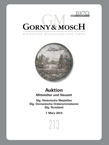 March 4-7, 2013
March 4-7, 2013
Gorny & Mosch
Auction sales 211-213
A fest for the aficionado of medals: auction sale 123 of Gorny & Mosch
A magnificent ensemble of historical medals manufactured by the best die cutters in their day will be offered in auction 213 of Munich auction house Gorny & Mosch, ranging from Hans Reinhart the Elder to Sebastian Dadler, from Johann Höhn and P. H. Müller, to state just a few illustrious names here.
Thursday, March 7, is focused on the medals, although several numismatic and phaleristic rarities from Germany, Europe, Russia and overseas will compete for the collectors’ attention.
Hardly any other numismatic genre has more to offer and is (yet) as underestimated as the medal. Several important die cutters are present there, from Hans Reinhart the Elder to Sebastian Dadler and Johann Höhn as well as P. H. Müller whose great works the collector had bought. The estimates range from 50 euros to 30,000 euros. Hence, there is something here for everyone.
Let’s begin with the medals of the 16th century, the Renaissance works of art that depict the leading figures of the Reformation. The medals and a commemorative coin, respectively, display three variants of Frederick the Wise at once (VF-EF; VF; and VF-EF; estimates: 5,000, 7,500 and 4,000 euros, respectively). The catalog puts a special emphasis on the fantastic medals of the Leipzig artist Hans Reinhart the Elder. The aficionados encounter, amongst other pieces, his medal on the Fall of Man and the Salvation (EF, original cast; estimate: 5,000 euros), his elaborate portrait of Charles V (old cast, EF; estimate: 1,000 euros), his extremely rare work about the apocalypse (EF, original cast; estimate: 4,000 euros) and the famous Trinity medal as his most groundbreaking and at the same time most mature work (EF; original cast; estimate: 30,000 euros).
Sebastian Dadler most certainly was the most prominent die cutter of the 17th century. The collector was able to acquire highlights of his work in finest conditions, like a splendid specimen of the medal 1634 on the burial of Gustavus II Adolphus in Stockholm (FDC; estimate: 5,000 euros) or a medal from 1649 on Emperor Ferdinand III and the Nuremberg day of execution (EF-FDC; estimate: 15,000 euros).
The medals spanning the period of time from the 18th to the 20th century likewise contain some rarity, like an extremely rare gold medal of 15 ducats from 1814 on the triumphal march of the allied forces against Napoleon and the Treaty of Paris (EF; estimate: 22,000 euros).
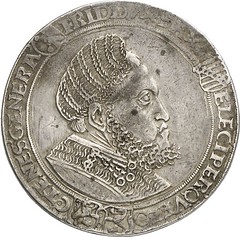
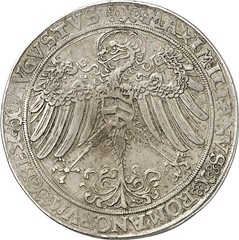
Lot 4003. Historical medals / Saxony. FREDERICK III the Wise, 1486-1525. Guldengroschen (1513), Nuremberg, on the dignity of the general stadtholder. Merseburger Coll. 419. Extremely rare. Very fine. Estimate: 7,500 euros.
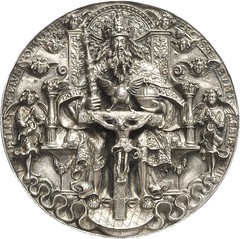

Lot 4011. Historical medals. TRINITY MEDALLION of Hans Reinhart the Elder, 1544. Habich 1962var. From Eugen Felix Coll., auction A. Hess Nachf., Frankfurt 1895, lot 232. Estimate: 30,000 euros.
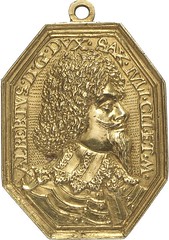
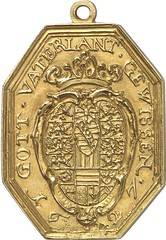
Lot 4038. Historical medals / Saxe-Eisenach. ALBRECHT, Duke 1641-1644. As administrator of the Teutonic Order bailiwick Thuringia. Octagonal golden gnadenpfennig 1627. Tentzel pl. 37.1. From WAG (09/2006), 2459. Of greatest scarcity. Gorgeous original cast. Extremely fine. Estimate: 17,500 euros.

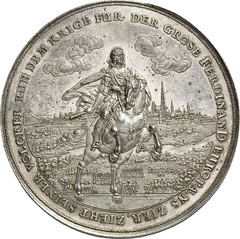
Lot 4053. Historical medals / HRE. FERDINAND III, 1637-1657. Medal 1649 of S. Dadler on the Nuremberg day of execution. Montenuovo Coll. 821. Very rare. Extremely fine to proof-like. Estimate: 15,000 euros.
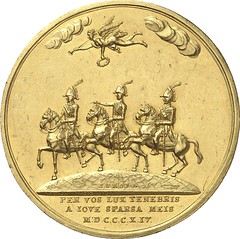

Lot 4295. Historical medals / Brandenburg-Prussia. Gold medal of 15 ducats 1814 of Ascher Wappenstein on the triumphal march of the allied forces against Napoleon and the Treaty of Paris. From auction sale UBS 53, lot 831. Montenuovo Col. cf. 2391 (silver). Very rare. Extremely fine. Estimate: 22,000 euros.
The catalog can be viewed on the internet at www.gmcoinart.de and ordered at Gorny & Mosch, Giessener Münzhandlung, Maximiliansplatz 20, D-80333 Munich, phone +49 / (0)89 / 24 22 643-0, fax +49 / (0)89 / 22 85 513.
KÜNKER AUCTIONS MARCH 11 TO 16, 2013
Six important coin collections and countless smaller ones are hidden in the six auction catalogs illustrating the items to be auctioned off by Osnabruck auction house Künker between March 11 and 16, 2013. The scope ranges from ancient times to present, with a significant focus on the Middle Ages.
These are not mere auction catalogs of Künker’s but reference works on special fields of interest. Many collectors trust in the expertise Künker spends on presenting its coins to a broad audience. Let us first have a look at the auction week’s highlights. Scheduled are for day one the Koch Collection Ancient Coins, as well as the Dr Curti Collection Medieval Coins, on day three a special collection Cologne, Rhineland, Westphalia, and on the fourth day a second special collection Nuremberg, Franconia, as well as some splendid gold coins from the Vogel Collection. The sixth and final day is devoted to the Sultan Collection, the most comprehensive collection of coins of the Ottoman Empire ever assembled in this quality.
This is just the tip of the iceberg. After all, the individual prices of the 7.475 lots add up to a total estimate of ca. 8 million euros. Of course, there are pieces available for high five-figure sums, but the major part of the stock ranges in the lower three-figure regions; thus, the average collector has every chance to expand its range by intriguing new acquisitions.
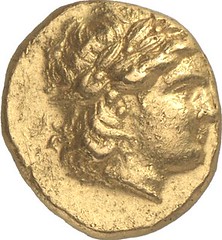
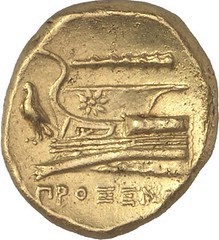
420: Greek coins. KIOS (Bithynia). Stater, 334-323. Wadd. pl. XLIX, 4. Good very fine. Estimate: 20,000 euros.


726: Roman coins. AUGUSTUS, 27 B. C. – A. D. 14. Cistophorus, 27/6 B. C., Pergamon. RPC 2209. Extremely fine. Estimate: 5,000 euros.
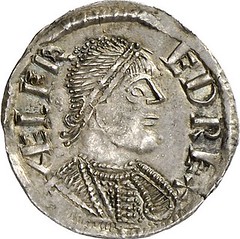
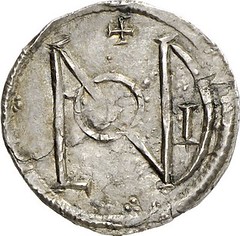
2342: England / Anglo-Saxon coins. ALFRED, 871-899. Penny, London. North 644. Extraordinary portrait. From auction sale Gemini VI (2010), 935. About mint-state. Estimate: 18,000 euros. Although Alfred, surnamed The Great since he was one the most important kings of the Anglo-Saxons, was never canonized officially, a cult of his person nevertheless came into being centered at his tomb. The portrait on this coin is extraordinarily veristic and surely the best portrait of Britain of Anglo-Saxon times.
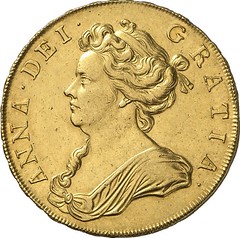
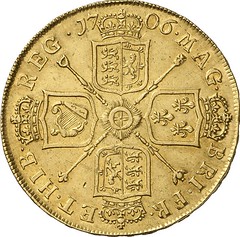
6656: England. ANNA, 1702-1714. 5 guineas 1706, London. Fb. 316. Rare. Extremely fine. Estimate: 18,000 euros.
To read the complete article, see:
Six Collections and a Good Deal More – Künker Auction March 11 to 16, 2013
(www.coinweek.com/auctions-news/six-collections-and-a-good-deal-more
-kunker-auction-march-11-to-16-2013/)
THE BOOK BAZARRE
1811 DISS VOLUNTEER INFANTRY MEDAL
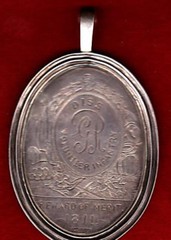 A silver 1811 Diss Volunteer Infantry medal, awarded to Jabez Waller, will be auctioned by James and Sons Auctioneers of Fakenham on January 30.
A silver 1811 Diss Volunteer Infantry medal, awarded to Jabez Waller, will be auctioned by James and Sons Auctioneers of Fakenham on January 30.
The oval and engraved medal has a triple-stepped rim and carries a guide price of between £500 and £800.
The Diss Volunteer Infantry would have been the ‘Dad’s Army’ of its day - organised as a trained force ready to fight if Napoleon ever decided to send his armies across the Channel.
Mr Waller appears to have been awarded the medal for his proficiency in military exercises, where the group were known to have drilled on Diss Common.
Rev Frank Howard, Diss Museum Trustees chairman, said: “We feel this would be a great thing for the town to have and see.”
To read the complete article, see:
Diss Museum in bid for rare medal for 1800s ‘Dad’s Army’
(www.dissexpress.co.uk/news/latest-news/diss-museum-in-bid-for-rare-medal
-for-1800s-dad-s-army-1-4718082)
LOST WWI MEDAL FOUND IN SEWER RETURNED TO OWNERS
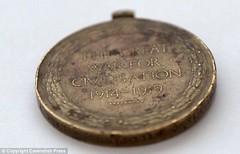 The family of a soldier killed in the First World War have been reunited with his Victory medal - after it turned up in a sewer.
The family of a soldier killed in the First World War have been reunited with his Victory medal - after it turned up in a sewer.
Private Charles William Curtin was killed at Ypres in May 1915, aged just 35, and the posthumous award for his bravery in France was all his young family had left of him. But the bronze campaign medal went missing and was not seen for more than 70 years.
Now the heirloom has been returned to Pte Curtin's grandchildren John Hodgson and Dorothy Heed, after it was found in a Manchester sewer by a labourer.
The worker's sister-in-law, retired accountant Christine Wolstenholme, spent three years tracking down the family so she could return the treasure to its rightful home.
The 66-year-old's achievement is all the more impressive because the medal had been engraved with a slightly wrong name.
Mr Hodgson, from Poulton, near Blackpool said: 'The phone rang one day and this lady asked if I was John Hodgson and did I have relatives in Chorlton called Curtin.
'She said a family member of hers had been working in sewers in Manchester and had found a medal and she'd spent some years since trying to track the rightful owners down.
'I was quite amazed really. Especially as my cousin Anne had tried to trace where the medal had gone once. The fact she spent all this time doing the research for strangers is just amazing.'
To read the complete article, see:
Missing First World War medal which was found dumped in a SEWER is returned to fallen soldier's family after 70 years
(www.dailymail.co.uk/news/article-2271184/Missing-First-World-War-medal
-dumped-SEWER-given-fallen-soldiers-family.html)
BOOK COLLECTING 101
Dennis Tucker writes:
It might just be me, but I believe far fewer ‘Physical Books are Dead’ articles are being published these days. Just as well because book collecting is alive and well, and co-existing happily alongside digital media. Avid readers are still becoming book collectors. Beautiful, rare and interesting editions are still being bought and sold.
The first question for any potential book collector to answer is ‘What should I collect?’ The answer is simple – collect the books you love. I always advise collecting for love rather than financial gain. It could be an author or a literary group, every possible edition of a single title, a genre or a sub-genre, an era or a publisher, first editions, signed copies or books illustrated by a particular artist.
Can you make money from collecting rare books? Yes, but like the stock market, the value of books can decrease as well as increase. Can you build a collection of valuable books? Again yes, but, again like the stock market, it takes knowledge and research to strike gold. Are books a good long-term investment? It depends – can you identify books that will gain value over a couple of decades?
Collecting books for financial gain is not easy. That’s why it’s good to start with the books you love and know well.
If you already have first editions from up-and-coming authors on your shelves, you need patience. The big bucks are generated by books from legends of literature such as Kipling, Hemingway, Kafka and Tolkien – writers who have inspired millions of readers. It can take a long time to become legendary.
Another key question is how much should be spent on a book collection? Thanks to the Internet, it’s easy to spend $40,000 on a signed first edition of Casino Royale by Ian Fleming. Set a budget and stick to it. If you are collecting books that have prices out of your reach, be smart – spread your net into charity book sales, library sales, and thrift shops. Spot undervalued copies and snap them up. I met one collector who loved first editions from Fleming but could not afford them – instead he bought later editions and added facsimiles of first edition dust jackets. Facsimile jackets can be bought for $20.
Dave Bowers adds:
About 10 to 20 years ago I thought it a nice idea to collect one each of the old editions of The Hardy Boys and Tom Swift. I bought a few at antiquarian book shows then learned of the leading dealer specialist. I then bought a couple dozen from that source, only to learn (from a bibliophile friend) that all of the dust jackets were fake. Andy Brown, who used to conduct the Gotham Book Store in NYC, also a friend, dealt in first-edition novels, charging market prices for rarities—but constantly being offered copies w repro covers.
In numismatics we are lucky that there are laws against counterfeiting (although not always easy to have enforced). For fake book jackets there is no consumer protection. Sellers usually show a picture or whatever and do not describe; buyers assume they are original!
To read the complete article, see:
Book Collecting 101
(www.publishersweekly.com/pw/by-topic/industry-news/tip-sheet
/article/55629-book-collecting-101.html)
BRANDYWINE RIVER MUSEUM EXHIBIT OF F.O.C. DARLEY'S BANK NOTES
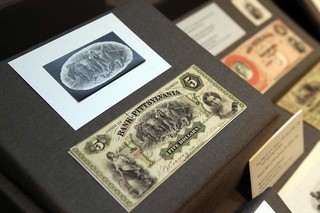 F.O.C Darley – a Philadelphia native who lived most of his life in Claymont – illustrated a short story for Edgar Allan Poe, “The Legend of Sleepy Hollow” for Washington Irving and several books for Charles Dickens.
F.O.C Darley – a Philadelphia native who lived most of his life in Claymont – illustrated a short story for Edgar Allan Poe, “The Legend of Sleepy Hollow” for Washington Irving and several books for Charles Dickens.
He also drew the illustrations for Clement Clarke Moore’s “A Visit From St. Nicholas,” Nathaniel Hawthorne’s “The Scarlet Letter,” James Fenimore Cooper’s “The Pioneers” and Sylvester Judd’s “Margaret.”
But what will really catch your eye in The Magic Pencil of the Amazing F.O.C. Darley, the featured exhibit now running at the Brandywine River Museum in Chadds Ford, Pa., is the bank notes. Darley illustrated hundreds of bank notes for the financial institutions of the mid-1800s, who all issued their own currency, as well as bonds and stock certificates.
All of the bank notes in the exhibit are from the personal collection of Dr. Terry A. Bryan of Dover, who advises the Darley Society on which notes they should collect. Some notes have novel designs, and some repeat the same images.
“The sad thing is that he didn’t put his name on the bank notes, and there were others doing it, too,” said Gail Stanislow, the museum’s librarian and an enthusiastic member of the Darley Society. But Darley did keep meticulous records of his commissions, and that record book is at the American Antiquarian Society, a resource for collectors.
Curator Audrey Lewis said she hopes people will leave the exhibit understanding what a fabulous illustrator Darley was.
“He really isn’t known, but he was so popular in his time that the books were advertised as being ‘illustrated by Darley,’” Lewis said.
Some Delaware area trivia fans might recognize Darley as the artist who created a Santa Claus in 1855, and he illustrated “A Visit with St. Nicholas” in 1862, prior to Thomas Nast drawing his chubby Santas, but similar in dress and design.
Darley was born in Philadelphia in 1822 and was a self-taught artist. He was working as a clerk at the Philadelphia Dispatch Transportation Line when a magazine editor saw his drawings of people on the street and asked him to illustrate a story. Over time, his drawings were so well received that Poe personally picked him to illustrate “The Gold Bug” in 1943 for The Dollar Newspaper.
To read the complete article, see:
F.O.C. Darley's bank notes on exhibit at Brandywine River Museum
(www.delawareonline.com/article/20130201/LIFE/302010030/F-O-C-Darley
-s-bank-notes-exhibit-Brandywine-River-Museum)
THE HIGHLAND MINT AND THE 2013 SUPERBOWL COIN
Every Super Bowl begins with a coin toss -- And that coin is made right here in Central Florida.
Brevard County’s Highland Mint is making the coin you’ll see tossed at the start of Super Bowl 47.
For the Melbourne-based company, this time of year is super. It's the time of year for the NFL's championship game.
“As we like to say, the game doesn't start without our coin,” said Highland Mint President Michael Kott.
In the days leading up to the big event, workers were busy making, cleaning and creating Super Bowl commemorative coins.
“What's special about this coin is that it's actually used in the game. Most of the time on TV, they show the coin toss and it's the exact coin you can purchase,” explained Kott.
The company will make 10,000 coins in all this year, putting the spotlight on the Baltimore Ravens and San Francisco 49ers.
Fifty go to the NFL, for the owners, players and others.
The remaining 9,950 can be yours for $99.
“The first one is numbered one, we send it to the NFL, the other ones, same production, same dye, same everything, gets reproduced,” said Kott.
Highland Mint employee Hope Hazard puts on the finishing touches for the coin displays with pride in her hometown company. “It's really cool we get to do it in town, and then get to see it on television,” said Hazard.
To read the complete article, see:
Super Bowl doesn't start without Melbourne company's coin
(www.cfnews13.com/content/news/cfnews13/news/article.html
/content/news/articles/cfn/2013/2/1/super_bowl_doesn_t_s.html)
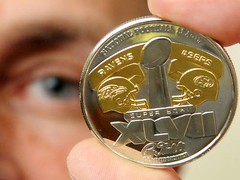 The Highland Mint commemorative, 1.5-inch diameter coin, not only will be used in the coin flip but also goes to the Pro Football Hall of Fame as part of its Super Bowl XLVII display. The remaining 99 coins of the first 100 coins pressed are given to players and NFL dignitaries.
The Highland Mint commemorative, 1.5-inch diameter coin, not only will be used in the coin flip but also goes to the Pro Football Hall of Fame as part of its Super Bowl XLVII display. The remaining 99 coins of the first 100 coins pressed are given to players and NFL dignitaries.
The coins, made of silver with gold highlights, usually sell out, but with more popular teams with bigger fan bases, Kott sometimes also can sell special framed packages that might include a Super Bowl program, a piece of the turf, or a section of one of the game footballs.
Since opening its doors nearly a quarter-century ago, the privately held Highland Mint has been building up a sports commemorative company that makes coins and other products for all major sporting events and theme parks like Disney and Universal.
To read the complete article, see:
Fans, NFL flip over Super Bowl coi
(www.usatoday.com/story/money/business/2013/02/01/
super-bowl-commemorative-coins/1883045/)

To read the complete article, see:
Fla. firm makes coin for Super Bowl
(www.usatoday.com/media/cinematic/video/1883097/fla-firm
-makes-coin-for-super-bowl/)
FEATURED WEB PAGE: NATIONAL NUMISMATIC COLLECTION
This week's Featured Web Page is the National Numismatic Collection of the Smithsonian Institution, suggested by Dave Lange.
Welcome to the National Numismatic Collection (NNC) of the Smithsonian Institution, one of the largest numismatic collections in the world and the largest in North America. Located in the National Museum of American History, Behring Center, the NNC includes approximately 1.6 million objects. There are over 450,000 coins, medals and decorations and 1.1 million pieces of paper money (including the recently acquired “Confederate Treasury horde” of cancelled Confederate paper money) in the collection, highlighting the entire numismatic history of the world.
The NNC contains many great rarities in coins and currency, from the earliest coins created 2,700 years ago up to the latest innovations in electronic monetary exchange, as well as fascinating objects such as beads, wampum, dentalia, and other commodities once used as money.

/americanhistory.si.edu/collections/numismatics/

